Widcomm WBG-1000 Bluetooth Network Access Point, Bluegate1000 User Manual
Widcomm, Inc. Bluetooth Network Access Point, Bluegate1000
Widcomm >
manual
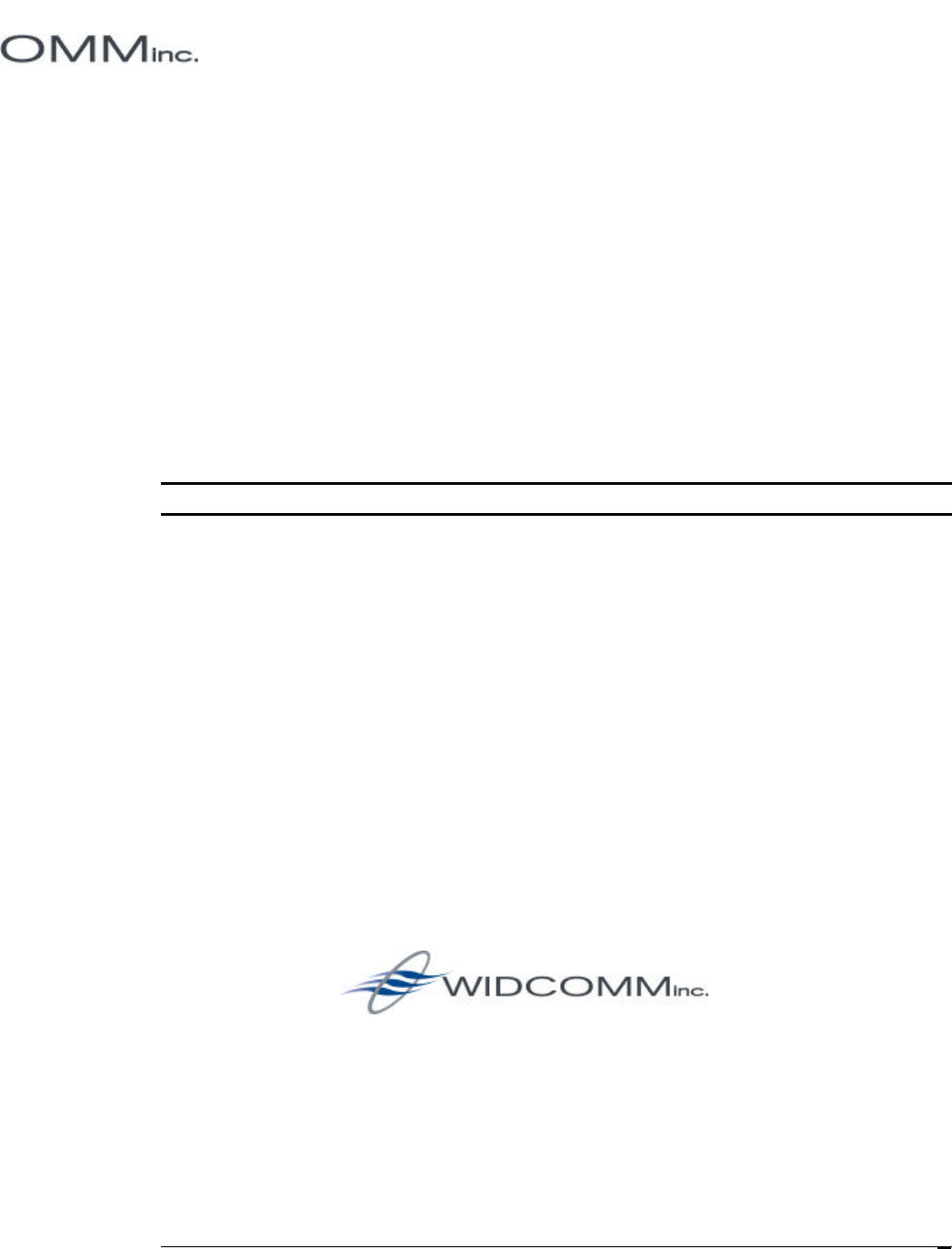
Wireless Internet and Data Communication
9645 Scranton Road, Suite 205
San Diego, CA 92121
Phone: 858.453.8400
Fax: 858.453.5735
Email
Technical Support: support@widcomm.com
Information: info@widcomm.com
Media Access
BlueGate 1000
Administrator’s Guide
May 8, 2001
Document Number: 010501-0619-BG-AdminGuide
Version: 2.0
Confidential and Proprietary Information

BlueGate 1000
May 8, 2001 WIDCOMM, Inc, Proprietary and Confidential i
FCC Statement
Widcomm Inc., 9645 Scranton Road, Suite 205, San Diego, CA 92121, 858-453-8400.
BlueGate , WDC-WBG-1000.
This device complies with part 15 of the FCC Rules. Operation is subject to the following two
conditions: (1) This device may not cause harmful interference, and, (2) This device must accept
any interference received including interference that may cause undesired operation.
Per CFR 47, PART 15, Paragraph 15.21: User changes or modifications not expressly approved by
the party responsible for compliance could void the users authority to operate the equipment.
Application PKLWBG-1000
Additional Information for the FCC approval of Widcomm Inc.’s BlueGate 1000
RF Exposure Statement
IMPORTANT NOTE: To comply with FCC RF exposure compliance requirements the following
antenna installation and device operating configurations must be satisfied:
The BlueGate 1000 unit must be placed on a desk or table such that a minimum normal operating
distance of 20 cm is maintained from the body at all times.
Copyright and Trademark Notices
Copyright 2000 – 2001, Widcomm, Inc. (“Widcomm”). All rights reserved. This documentation
may be printed and copied solely in connection with developing products in accordance with the
license agreement provided to you with this documentation. Only two (2) copies of this
documentation may be made for archival and backup purposes. Except for the foregoing, no part
of this documentation may be reproduced or transmitted in any form or by any means or used to
make any derivative work (such as translation, transformation or adaptation) without the express
written consent of Widcomm.
Widcomm, the Widcomm logo, BlueGate, and BlueConnect are trademarks of Widcomm.
Handspring and Visor are registered trademarks of Handspring, Inc. HotSync, Palm Computing,
and Palm OS are registered trademarks of Palm, Inc. Microsoft and Windows are registered
trademarks of Microsoft Corporation. Other brand and product names may be registered
trademarks or trademarks of their respective holders.

BlueGate 1000 Table of Contents
May 8, 2001 WIDCOMM, Inc, Proprietary and Confidential ii
Table of Contents
1INTRODUCTION.........................................................................................................1
2KIT CONTENTS ..........................................................................................................2
3INSTALLATION..........................................................................................................3
4RESET BLUEGATE 1000 ............................................................................................4
5ACCESS THE INTERNAL WEB SERVER .................................................................5
5.1 IP ADDRESS IN A DHCP ENVIRONMENT.................................................................5
5.1.1 Java Run-time Environment ............................................................................6
1. IP ADDRESS IN A NON-DHCP ENVIRONMENT ........................................................8
6INTERNAL WEB SERVER .......................................................................................11
6.1 HELP.....................................................................................................................12
6.2 STATUS .................................................................................................................12
6.2.1 BG Configuration .........................................................................................12
6.2.2 ARP Table ...................................................................................................14
6.2.3 Routing Table...............................................................................................15
6.2.4 NS Lookup...................................................................................................15
6.2.5 Authentication Table.....................................................................................16
6.3 STATISTICS ...........................................................................................................16
6.3.1 IP ................................................................................................................17
6.3.2 COM1 & COM2 ..........................................................................................17
6.3.3 MAC...........................................................................................................18
6.3.4 History of Active BT Connections .................................................................19
6.4 SHOW DHCP TABLE.............................................................................................19
6.5 PING .....................................................................................................................20
6.6 CONFIGURE BLUEGATE 1000 ...............................................................................20
6.6.1 Main Page....................................................................................................22
6.6.1.1 Please Enter Command: Field .........................................................23
6.6.1.2 Setup (BlueGate)............................................................................23
6.6.1.2.1 Device Name.........................................................................................24
6.6.1.2.2 Service Name........................................................................................24
6.6.1.2.3 IP Addr....................................................................................................24
6.6.1.2.4 Gateway..................................................................................................25
6.6.1.2.5 Subnet Mask..........................................................................................25
6.6.1.2.6 Primary DNS.........................................................................................26
6.6.1.2.7 Secondary DNS....................................................................................26
6.6.1.2.8 DHCP ......................................................................................................27
6.6.1.2.9 NAT.........................................................................................................27
6.6.1.2.10 Encryption............................................................................................27
6.6.1.2.11 Point-to-Multipoint...........................................................................27
6.6.1.2.12 Authorization......................................................................................28
6.6.1.2.13 Authentication.....................................................................................28
6.6.1.3 Authentication................................................................................31
6.6.1.4 Authorization.................................................................................32
6.6.1.5 IP Addresses for BT devices...........................................................33
6.6.1.6 Download......................................................................................34

BlueGate 1000 Table of Contents
May 8, 2001 WIDCOMM, Inc, Proprietary and Confidential iii
6.6.1.7 Reset.............................................................................................34
6.6.1.8 Help ..............................................................................................36

BlueGate 1000 Table of Contents
May 8, 2001 WIDCOMM, Inc, Proprietary and Confidential iv
7COMMAND LINE ENTRY........................................................................................37
7.1 ? OR HELP...........................................................................................................37
7.2 ARP .....................................................................................................................37
7.3 AUTHENTICATE...............................................................................................37
7.4 CONFIG..............................................................................................................37
7.5 CONSTANTPIN..................................................................................................37
7.6 DEVICEIPADDR ................................................................................................38
7.7 DEVICENAME...................................................................................................38
7.8 DNS......................................................................................................................38
7.9 ENABLEDHCP ...................................................................................................38
7.10ENABLENAT ......................................................................................................38
7.11ENCRYPT...........................................................................................................39
7.12GATEWAY..........................................................................................................39
7.13IPADDR...............................................................................................................39
7.14MULTIPOINT.....................................................................................................39
7.15NSLOOKUP ........................................................................................................39
7.16PASSWD..............................................................................................................39
7.17PINCODE............................................................................................................40
7.18PING....................................................................................................................40
7.19RESET.................................................................................................................40
7.20ROUTE................................................................................................................40
7.21SERVICENAME.................................................................................................40
7.22STATISTICS.......................................................................................................41
7.23SUBNET..............................................................................................................41
7.24USERLOGIN.......................................................................................................41
7.25USERNAME........................................................................................................41
7.26VERSION............................................................................................................41
8TROUBLESHOOTING..............................................................................................42
8.1 GENERAL..............................................................................................................42
8.2 ADMINISTRATIVE PASSWORD LOST ......................................................................42
8.3 BLUETOOTH DEVICE ADDRESS IS MISSING...........................................................42
8.4 BT LIGHT DOES NOT BLINK..................................................................................42
8.5 CAN’T LOG ON AS ADMINISTRATOR.....................................................................42
8.6 CANNOT CONNECT TO THE LAN ACCESS PROFILE SERVICE.................................43
8.7 CANNOT DISCOVER SERVICES ..............................................................................43
8.8 CLIENT DISPLAYS A SECURITY DIALOG; CONNECTION FAILS ...............................43
8.9 DIFFERENTIATING BETWEEN MULTIPLE BLUEGATE 1000 DEVICES .....................43
8.10ETHERNET LIGHT IS OFF OR NOT BLINKING........................................................43
8.11MAC ADDRESS IS MISSING OR NOT VALID ...........................................................44
APPENDIX A—AN INTRODUCTION TO BLUETOOTH .............................................A- 1

BlueGate 1000 List of Figures
May 8, 2001 WIDCOMM, Inc, Proprietary and Confidential v
List of Figures
Figure 1: BlueGate 1000 box and contents...............................................................2
Figure 2: BlueGate 1000 connector and LED locations............................................3
Figure 3: The serial number label, located on the bottom of BlueGate 1000.............7
Figure 4: JRE applet and the IE dialog box (inset) that displays the IP address......7
Figure 5: Two-node private network options...........................................................9
Figure 6: Crossover cable connections...................................................................10
Figure 7: BlueGate 1000's internal home page.......................................................11
Figure 8: Status > BG Configuration internal Web page. ......................................13
Figure 9: Status > ARP Table internal Web page. .................................................14
Figure 10: Status > Routing Table internal Web page. ...........................................15
Figure 11: Status > DNS Lookup internal Web page. .............................................15
Figure 12: Status > Authentication Table internal Web page. ................................16
Figure 13: The Statistics > IP internal Web page....................................................17
Figure 14: The Statistics > MAC internal Web page...............................................18
Figure 15: Statistics > History of Active BT Connections internal Web page..........19
Figure 16: The Show DHCP Table internal Web page............................................19
Figure 17: The Ping internal Web page and the results (inset) of pinging a remote
device......................................................................................................................20
Figure 18: The logon screen....................................................................................21
Figure 19: The Configuration internal Web page...................................................22
Figure 20: The Configuration > Setup (BlueGate) internal Web page. ...................29
Figure 21: The Configuration > Setup (BlueGate) update page appears when the
“Update” button is pressed to implement changes from the setup page..30
Figure 22: The Configuration > Authentication internal Web page........................31
Figure 23: The Configuration > Authorization internal Web page. ........................32
Figure 24: Configuration > IP Addresses for BT devices internal Web page. .........34
Figure 25: The Configuration > Reset confirmation dialog box..............................34
Figure 26: The internal Web page that appears after confirming a system reset. ...35
Figure 27: The Configuration > Help internal Web page........................................36

BlueGate 1000 Introduction
May 8, 2001 WIDCOMM, Inc, Proprietary and Confidential 1
1 Introduction
BlueGate™ 1000 provides access to a local area network (LAN) using wireless
technology. It is Bluetooth specification (1.0B) certified.
BlueGate 1000 also supports Bluetooth™ specification 1.1 critical errata.
Devices that can access the network through BlueGate 1000 are Personal Digital
Assistants (PDAs), computers, or other Bluetooth-enabled devices that support the
industry standard LAN Access Profile (LAP) portion of Bluetooth specification (1.0B).
Configuration information is saved in internal non-volatile memory and preserved even
when power is lost.
An on-board Web server is accessed to set up, diagnose, and configure BlueGate 1000.
Microsoft™ Internet Explorer™, version 5.0 or later, is used to access the internal Web
server from a computer on the same network subnet.
From the IE browser you can access the internal Web server to:
• Configure BlueGate 1000 for proper network operation.
• Change the user-friendly device name of BlueGate 1000.
• Access network diagnostic tools.
• Access BlueGate 1000 network statistics.
• Upgrade BlueGate 1000 software.
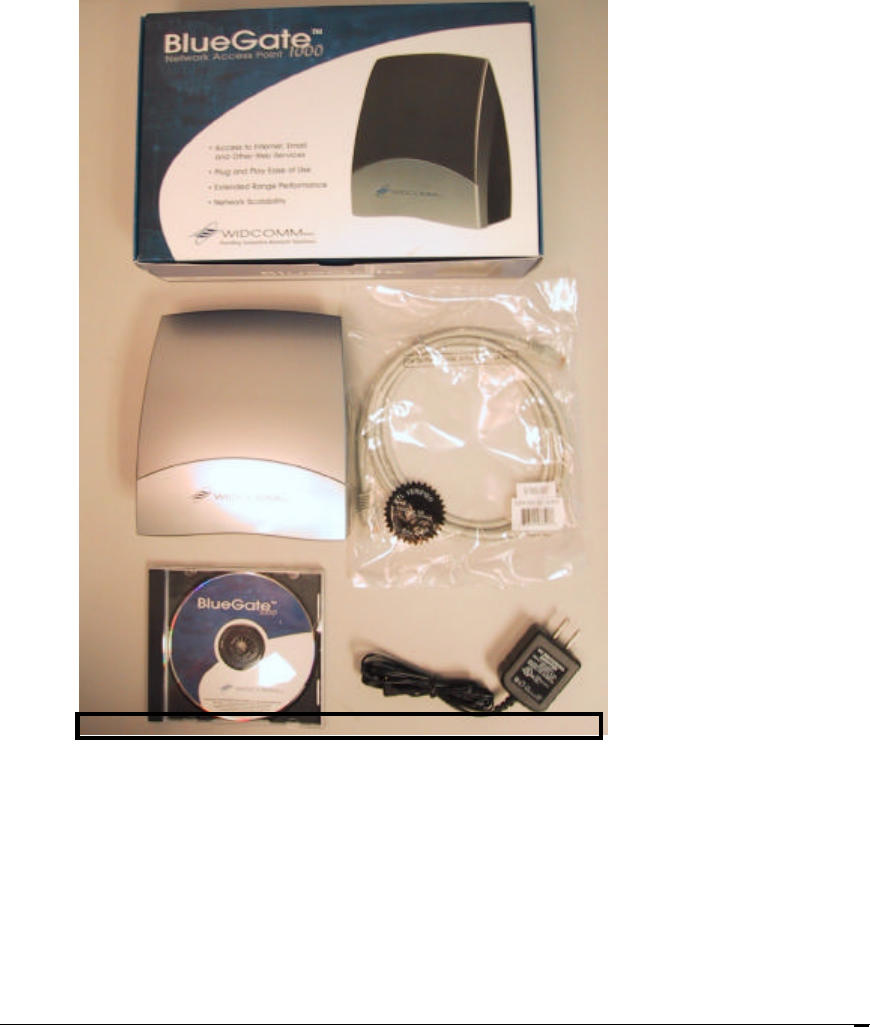
BlueGate 1000 Kit Contents
May 8, 2001 WIDCOMM, Inc, Proprietary and Confidential 2
2 Kit Contents
The BlueGate 1000 kit includes:
• A BlueGate 1000 network access point.
• An external power adapter.
• A standard Ethernet cable with an RJ-45 connector on each end.
• A compact disc that contains the BlueGate 1000 documentation and support
software.
• A “Start Here” quick start guide.
Figure 1: BlueGate 1000 box and contents.
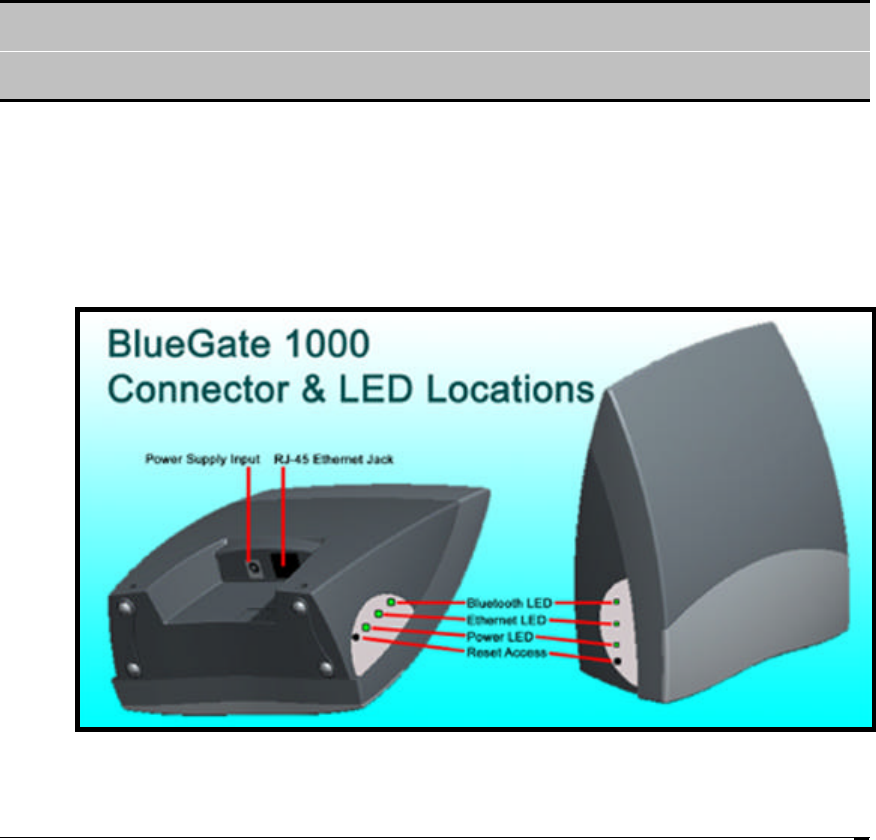
BlueGate 1000 Installation
May 8, 2001 WIDCOMM, Inc, Proprietary and Confidential 3
3 Installation
Before installing BlueGate 1000, you should be familiar with basic local area network
(LAN) and Bluetooth (BT) concepts.
For a non-technical overview of key Bluetooth concepts refer to Appendix A—An
Introduction To Bluetooth
1. Place BlueGate 1000 on a flat surface away from heat, moisture, open flames,
microwave devices and 2.4 GHz telephones.
2. Use the Ethernet cable provided in the kit to connect BlueGate 1000 to the local
area network.
See Figure 2 for the location of BlueGate 1000’s RJ-45 network connector.
The Ethernet cable can be plugged into a network switch or network hub, or into
a hardwired wall jack that connects to the network. Consult your network
administrator if you are unsure of where or how to establish a physical
connection to the network.
Route the network cable away from other cables that may cause electrical
interference. Avoid routing the cable through areas where it will be stepped on,
tripped over, or damaged in any way.
NOTE: Telephone connections often use the RJ-45 connector; some wall plates,
especially in office environments, have both telephone and network jacks in the
same plate. When connecting through a wall plate of this type verify the physical
connection between the jack and the network.
3. Plug the power supply into a wall outlet (120-220VAC, 60-50 Hz) and insert the
small circular power plug into the power jack on the back of BlueGate 1000
(Figure 2). When power is applied the bottom light emitting diode (LED) will
blink for 6 seconds and then stay on continuously.
If the LAN is 10Base-T or 100Base-T and a Dynamic Host Configuration Protocol
(DHCP) server is available, BlueGate 1000 is ready to use.
Figure 2: BlueGate 1000 connector and LED locations.
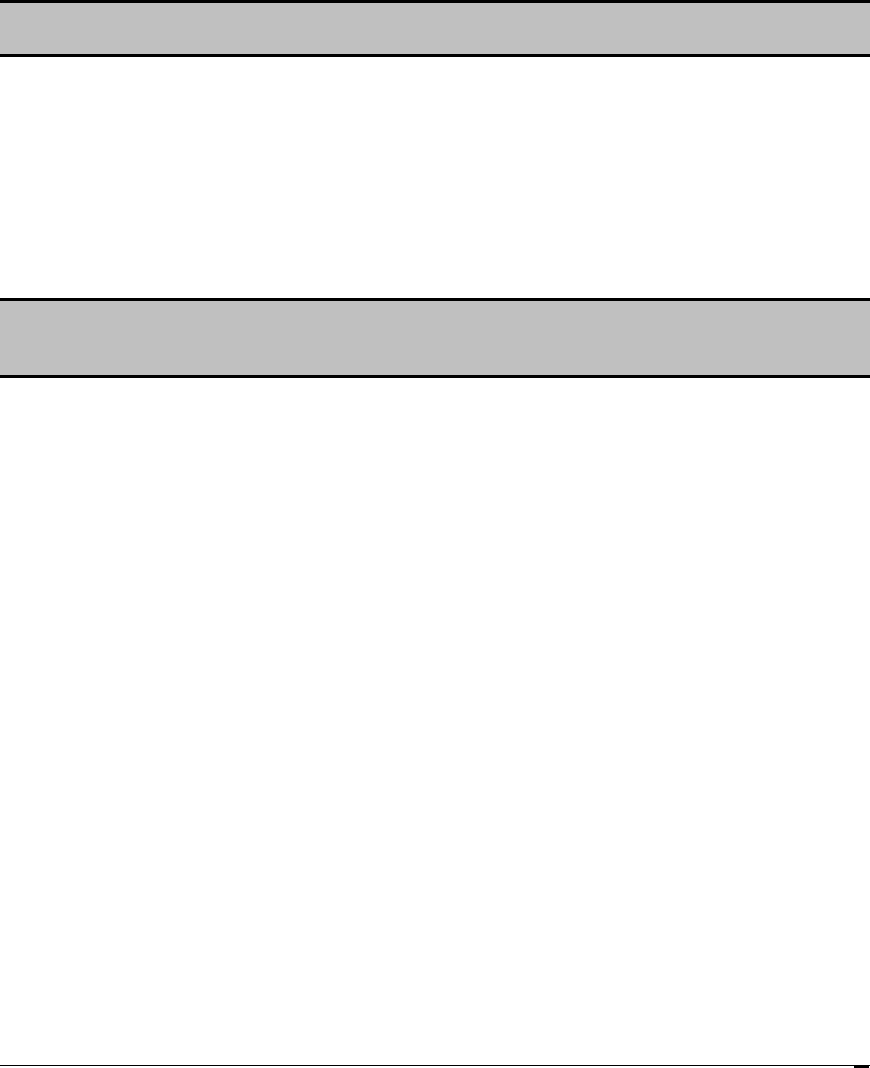
BlueGate 1000 Reset
May 8, 2001 WIDCOMM, Inc, Proprietary and Confidential 4
4 Reset BlueGate 1000
BlueGate 1000 can be reset in several ways:
1. Click the Reset button on any internal Web page that it appears on.
2. Physically remove power from BlueGate 1000:
§ Unplug the power to the unit.
§ Wait 30 seconds.
§ Plug the power back in.
3. Press the hardware reset button for five seconds (see Figure 2).
NOTE: When the hardware-reset button is used to reset BlueGate 1000 the “Admin” user
name and password are restored to the factory-default settings.
BlueGate 1000 can store up to seven user names and their associated passwords. The first
name in the list is “Admin”. The remaining user names/password entries are numbered
User one through User six.
“Admin” holds the administrator’s user name and password. The information that it
contains can be re-configured (see Section 6.6.1.4).
The “Admin” factory default settings are:
• User name = “widcomm”.
• Password = “admin”.
NOTE: When BlueGate 1000 is reset in a DHCP environment it is possible that it will have
a different IP address assigned to it by the server. See Section 5.1 for information
on how to obtain the new IP address.
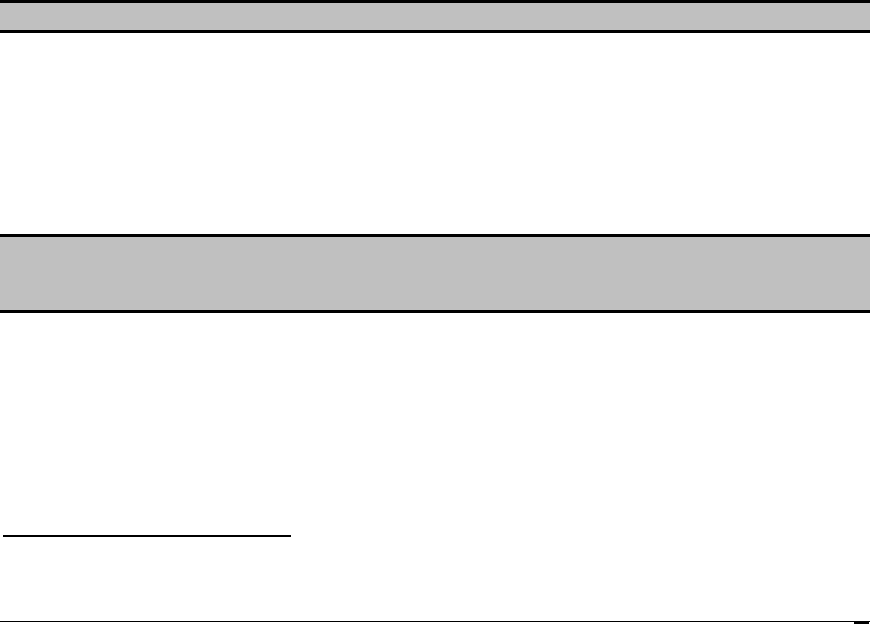
BlueGate 1000 Internal Web Server
May 8, 2001 WIDCOMM, Inc, Proprietary and Confidential 5
5 Access The Internal Web Server
BlueGate 1000 is setup and configured through an internal Web server.
Access to the internal Web server requires BlueGate 1000’s IP address.
In a Dynamic Host Configuration Protocol (DHCP) environment the server assigns
BlueGate 1000’s IP address automatically.
A Java applet1 that discovers BlueGate 1000’s dynamically assigned IP address is
included on the BlueGate 1000 compact disc (see Section 5.1).
In a non-DHCP environment BlueGate 1000 defaults to a static IP address that can be
used to access the internal Web server (see Section 5.2).
Refer to Section 6.6 for specific configuration options and information on how to use
them.
5.1 IP ADDRESS IN A DHCP ENVIRONMENT
To determine BlueGate 1000’s IP address:
1. Create a directory named C:\BGPolicy on the system hard drive.
2. Copy BGIPLookup.html, BGIPLookup.class, BGPolicy, and widcomm.jpg from
the root directory of the BlueGate 1000 compact disc to the new C:\BGPolicy
directory.
3. Run Microsoft Internet Explorer, version 5.0 or higher, and open
BGIPLookup.html from the C:\BGPolicy directory.
If the Java Run-time Environment is not installed on your system, you will be
prompted to download and install JRE from the Sun Microsystem’s Web site (see
Java Run-time Environment, Section 5.1.1). After completing the Java Run-Time
Environment installation, return to this step to complete the process of getting an
IP address.
NOTE: The Netscape browser is not supported in this release.
4. Enter the Media Access Control (MAC) address of BlueGate 1000 (located on
the label on the bottom of the unit, see Figure 3) and click the “Click here to Find
IP Addr of BG WebServer” button (DO NOT press enter).
The IP address of BlueGate 1000 is displayed in an Internet Explorer dialog box, (Figure
4, inset).
Click the OK button to close the dialog box and automatically open BlueGate 1000’s
internal Web page in Internet Explorer.
NOTE: The Java applet uses a UDP broadcast packet to interrogate BlueGate 1000 for its
assigned IP address. UDP packets are not routed; be sure there is not a router
between BlueGate 1000 and the computer.
1 An applet is a JAVA-based program that is downloaded by a browser.

BlueGate 1000 Internal Web Server
May 8, 2001 WIDCOMM, Inc, Proprietary and Confidential 6
5.1.1 Java Run-time Environment
If version 1.3 of the Java Run-time Environment (JRE) is not installed on your computer,
BGIPLookup.html (see above) will prompt you to install it from Sun Microsystem’s Web
site.
To install and configure JRE:
1. Select “Yes” when prompted to download JRE and follow the on-screen
instructions.
2. Close Internet Explorer.
3. Open
C:\ProgramFiles\JavaSoft\JRE\1.3\lib\security\java.security
in a text editor.
4. Insert a blank line after the line:
policy.url.2=file:${user.home}/.java.policy
5. On the blank line enter:
policy.url.3=file:/C:/BGPolicy/BGPolicy
This line points to the BGPolicy file in the C:\BGPolicy directory.
6. Save the file.
The Java Run-Time environment installation is complete. Return to Step 3 on page 5 and
complete the determination of BlueGate 1000’s IP address in a DHCP environment
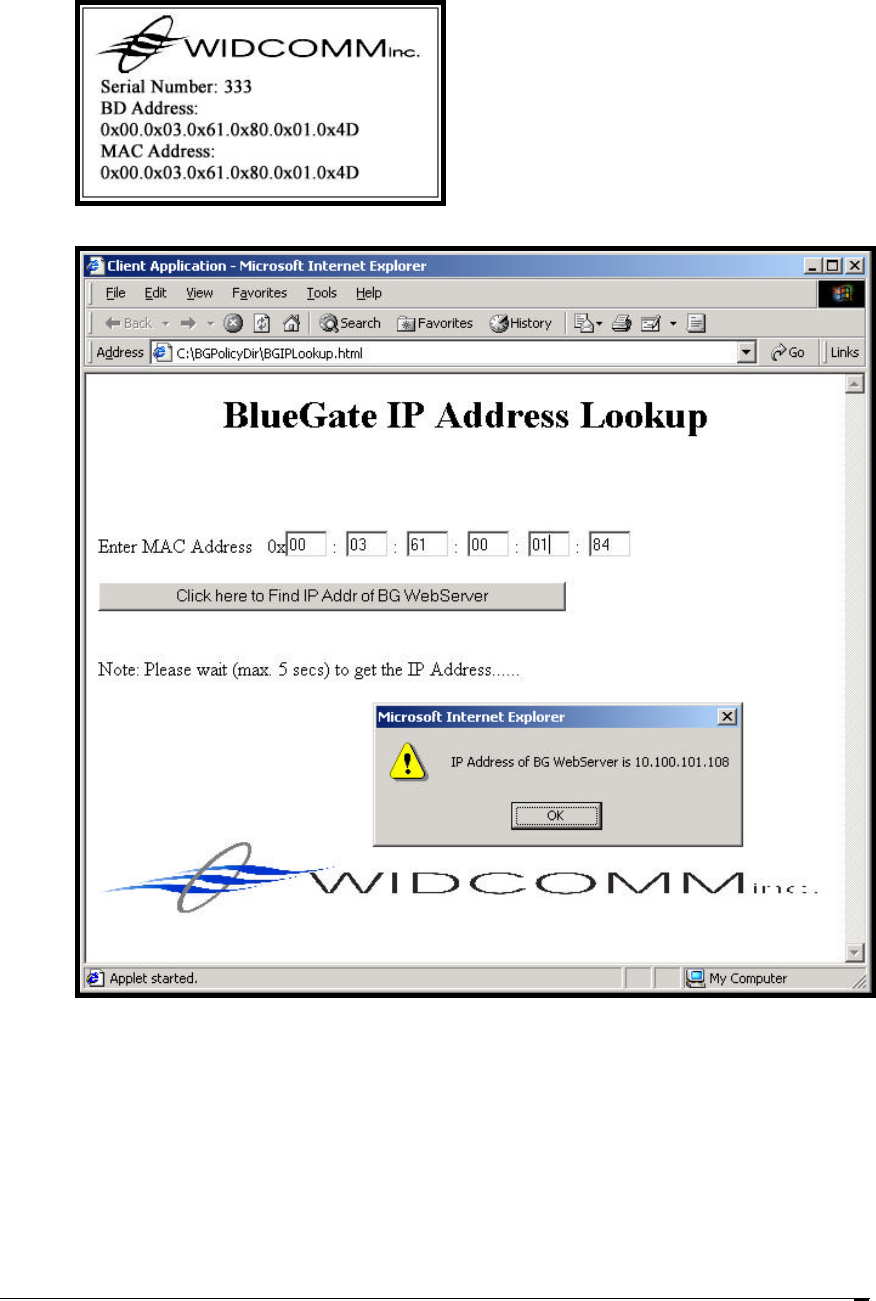
BlueGate 1000 Internal Web Server
May 8, 2001 WIDCOMM, Inc, Proprietary and Confidential 7
Figure 3: The serial number label, located on the bottom of BlueGate 1000.
Figure 4: JRE applet and the IE dialog box (inset) that displays the IP address.
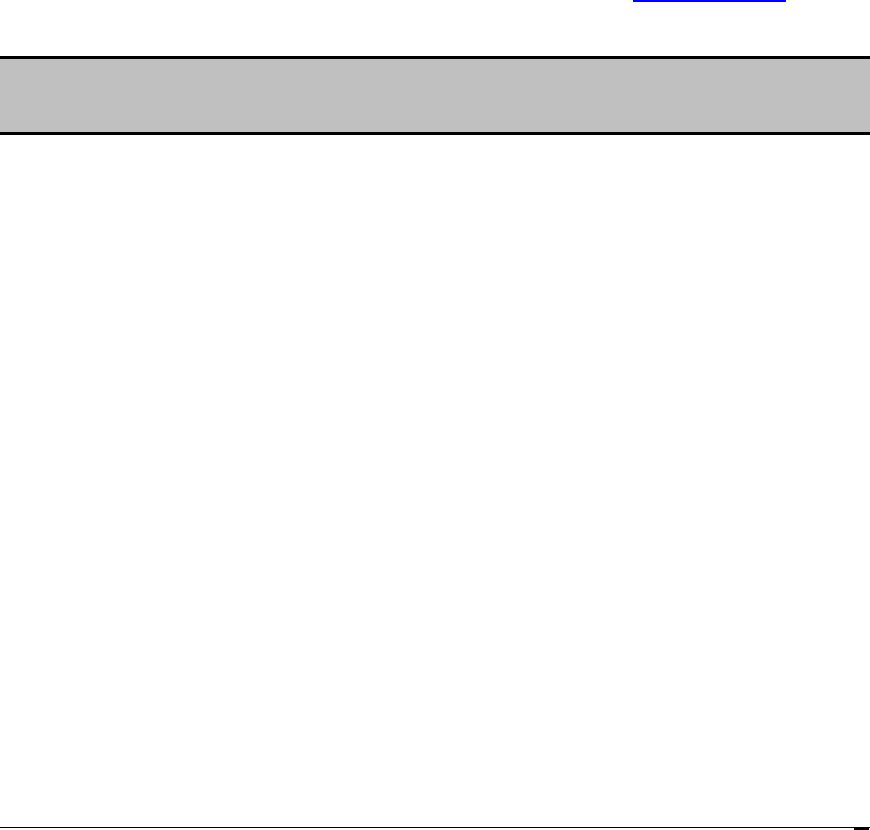
BlueGate 1000 Internal Web Server
May 8, 2001 WIDCOMM, Inc, Proprietary and Confidential 8
5.2 IP ADDRESS IN A NON-DHCP ENVIRONMENT
BlueGate 1000’s internal Web pages can be accessed using a static IP address.
When DHCP is enabled (factory default), the DHCP attempt must first timeout before
attempting to access BlueGate 1000’s internal Web pages using the static IP address.
After the DHCP timeout (120 seconds), BlueGate 1000 uses the configured static IP
address.
The factory-default static IP address is: 192.168.0.1.
To access BlueGate 1000’s internal Web server using the static IP address, create a two-
node private network between a single computer and BlueGate 1000:
1. Connect BlueGate 1000 and the computer (see Figure 5):
§ Solution One: use standard Ethernet cables to establish a connection through
a switch or hub.
§ Solution Two: use a crossover cable to create a direct connection. (Figure 6
shows the connections for a crossover cable.)
2. Configure the computer:
§ Static IP address of 192.168.0.2.
§ Subnet mask of 255.255.255.0.
3. Run Internet Explorer, version 5.0 or higher, and enter http://192.168.0.1 in the
address field.
4. Press ENTER or click Go.
NOTE: The default static IP address for BlueGate 1000 can be changed through the
Configuration > Setup option on the internal Web pages. If BlueGate 1000’s static
IP address has been reconfigured, enter the current address.
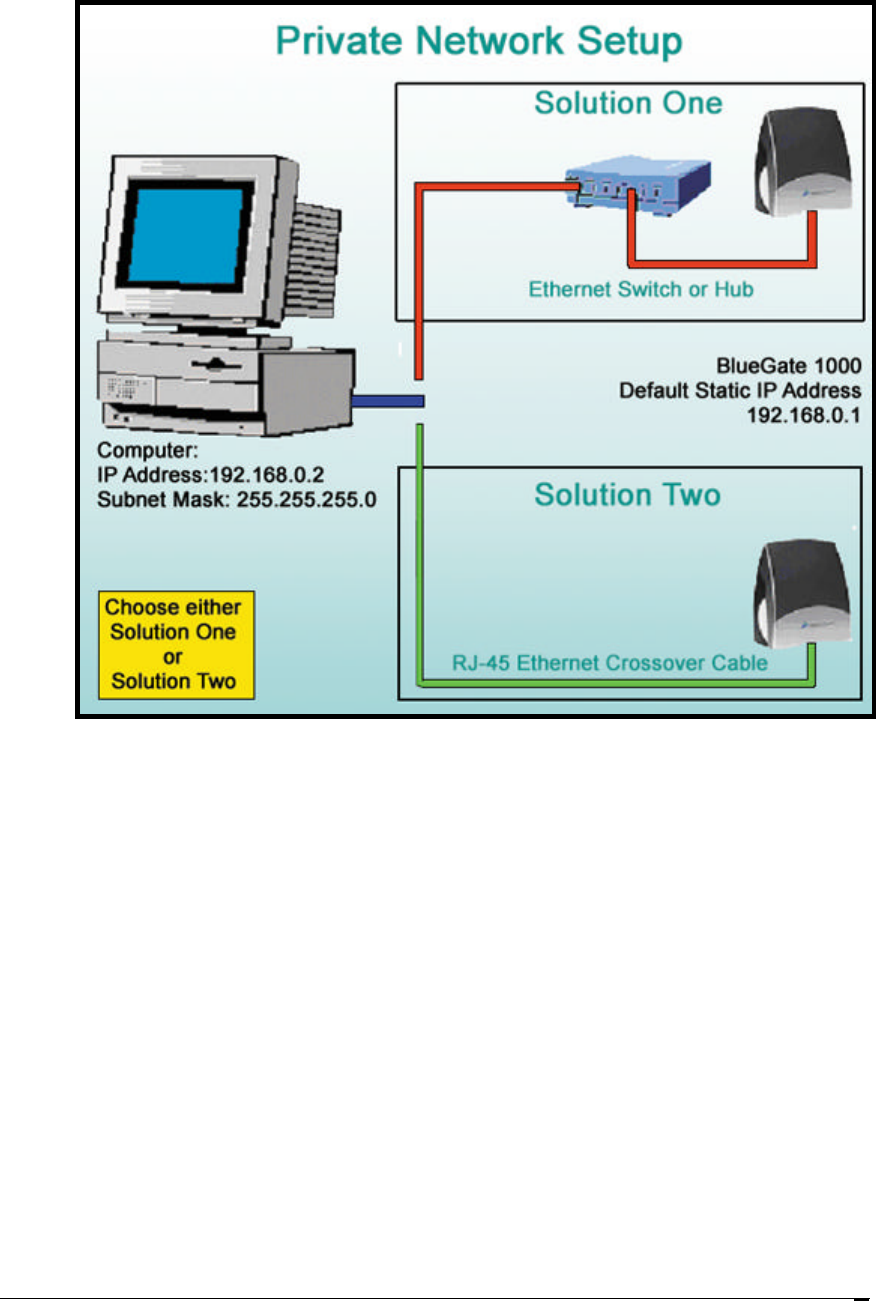
BlueGate 1000 Internal Web Server
May 8, 2001 WIDCOMM, Inc, Proprietary and Confidential 9
Figure 5: Two-node private network options.
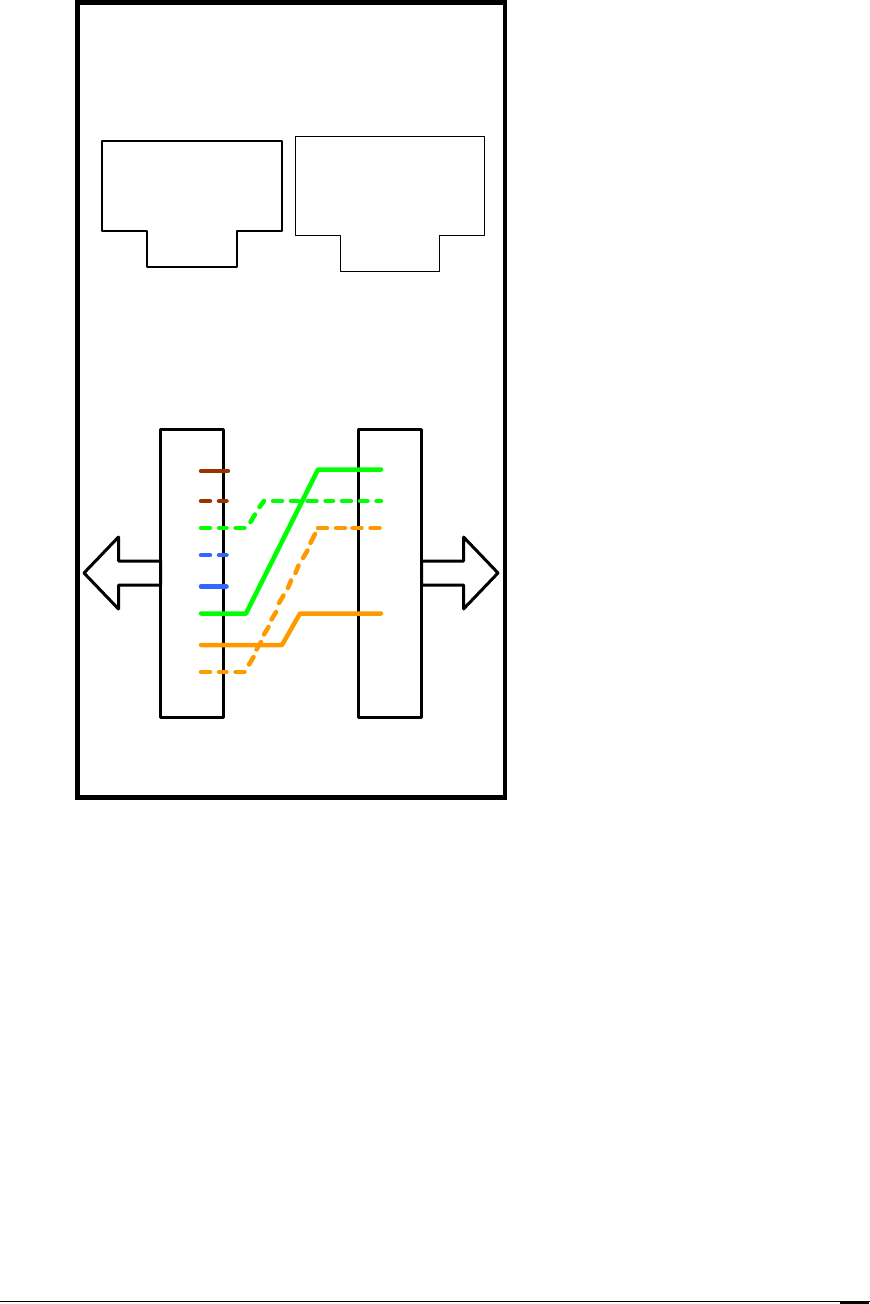
BlueGate 1000 Internal Web Server
May 8, 2001 WIDCOMM, Inc, Proprietary and Confidential 10
Figure 6: Crossover cable connections.
8 7 6 5 4 3 2 1 1 2 3 4 5 6 7 8
Jack
(Female)
Looking at the
cavity in the wall.
Plug
(Male)
Looking at the
connector with the
cable running
away from you.
Ethernet 10Base-T and 100Base-T
use pairs 2 & 4 (Pins 1 & 2 and 3 & 6).
1
2
3
4
5
6
7
8
8
7
6
5
4
3
2
1
To Jack To Jack
Plug 1 Plug 2
Ethernet 10/100 Crossover Cable
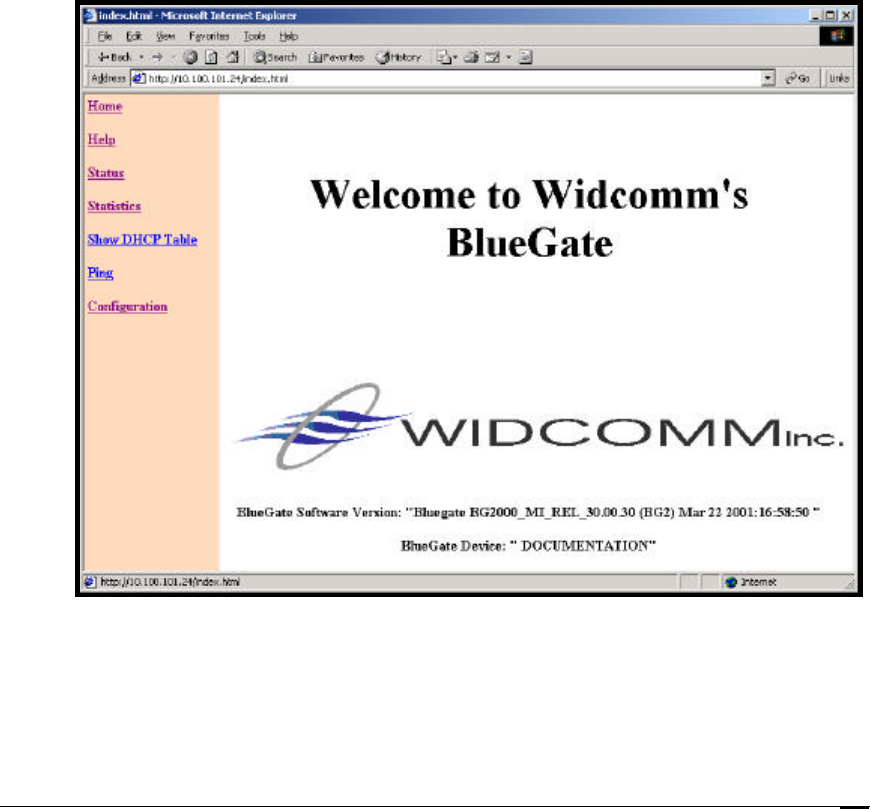
BlueGate 1000 Internal Web Server
May 8, 2001 WIDCOMM, Inc, Proprietary and Confidential 11
6 Internal Web Server
To access BlueGate 1000’s internal Web server:
• In a DHCP environment:
1. Run Internet Explorer and open the Java applet BGIPLookup.html (see
section 5.1 for details)
2. Enter BlueGate 1000’s Media Access Control (MAC) address from the label
on the bottom of BlueGate 1000.
3. Click OK in the dialog box that returns the IP address. The internal home
page opens automatically in Internet Explorer.
• In a non-DHCP (private network) environment (see section 5.2 for details about
setting up a private network):
1. Run Internet Explorer.
2. Enter http://192.168.0.1 in the address area.
3. Click Go or press the ENTER key. BlueGate 1000’s internal home page
opens in Internet Explorer.
In the figures in this section, the Java applet BGIPLookup.html was used to obtain the
DHCP server-assigned IP address and open the internal home page.
Figure 7: BlueGate 1000's internal home page.
Click the Home hyperlink on the left edge of any internal Web page to return to the home
page.
The remainder of this section describes the internal Web pages associated with the other
hyperlinks in the left pane of Internet Explorer.

BlueGate 1000 Internal Web Server
May 8, 2001 WIDCOMM, Inc, Proprietary and Confidential 12
6.1 HELP
The Help hyperlink displays an internal Web page with links to on-line resources:
• BlueGate technical support.
• The WIDCOMM Web site.
6.2 STATUS
The Status hyperlink displays an internal Web page that provides access to additional
pages that contain information related to the network and Bluetooth settings of
BlueGate 1000.
The links at the top of the Status page display:
• BG Configuration—basic network and Bluetooth security settings.
• ARP Table—the active Address Resolution Protocol entries.
• Routing Table —the active routing entries.
• NS Lookup—a list of recently accessed IP addresses and the host names
associated with them.
• Authentication Table —the Bluetooth authentication-level security table.
6.2.1 BG Configuration
The Status > BG Configuration internal Web page (Figure 8) displays Bluetooth and
network settings, including:
• Bluetooth security configuration settings:
§ Authorization.
§ Authentication.
§ Encryption.
• Manufacturing configuration settings:
§ MAC (Media Access Control) address.
§ BD Addr (Bluetooth Device address).
• Public network configuration settings:
§ IP (Internet Protocol) address.
§ Gateway.
§ Subnet Mask.
§ Primary DNS (Domain Name System) Server.
§ Secondary DNS Server.
• Private network configuration settings:
§ IP address.
§ Gateway.
§ Subnet Mask.
§ DHCP.
§ NAT.
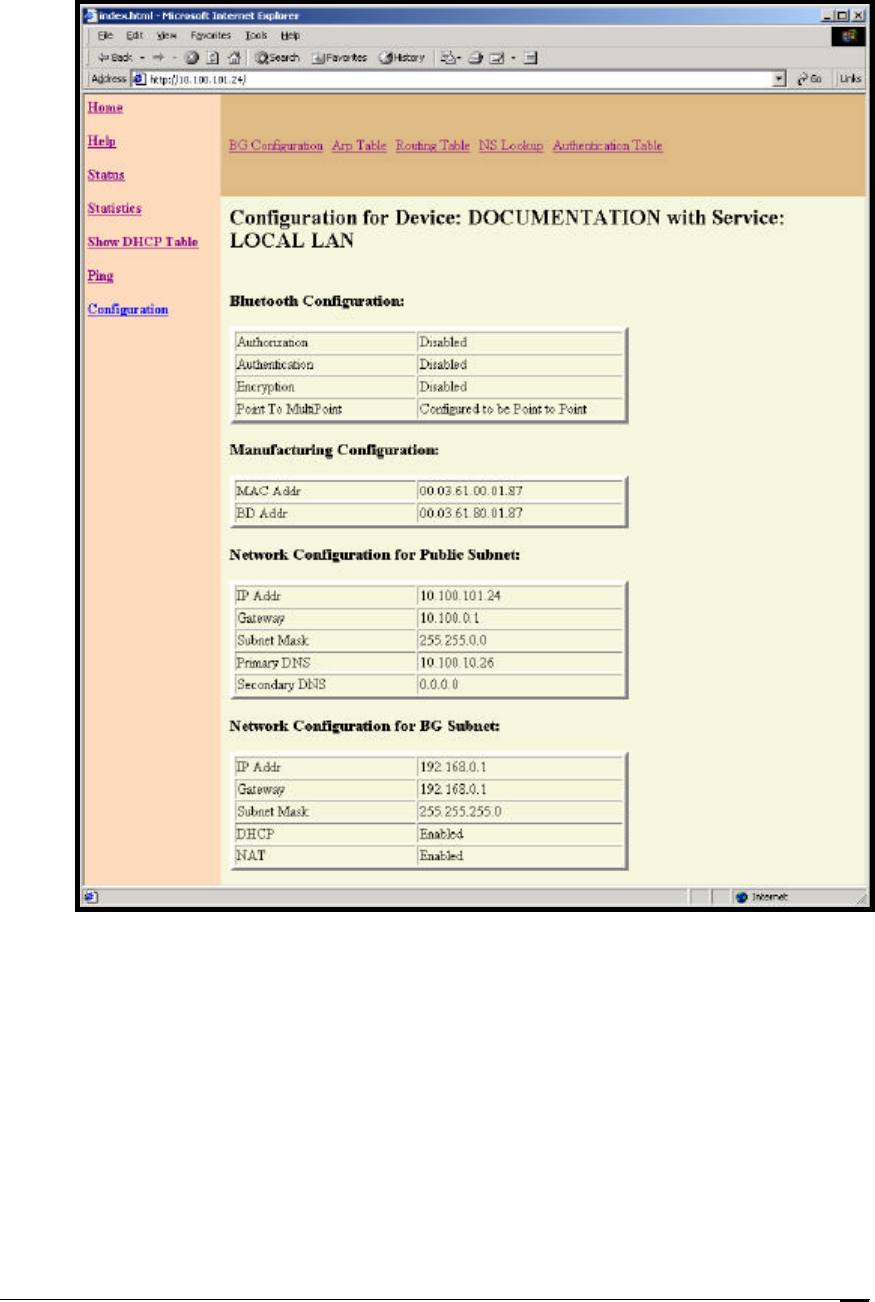
BlueGate 1000 Internal Web Server
May 8, 2001 WIDCOMM, Inc, Proprietary and Confidential 13
Figure 8: Status > BG Configuration internal Web page.
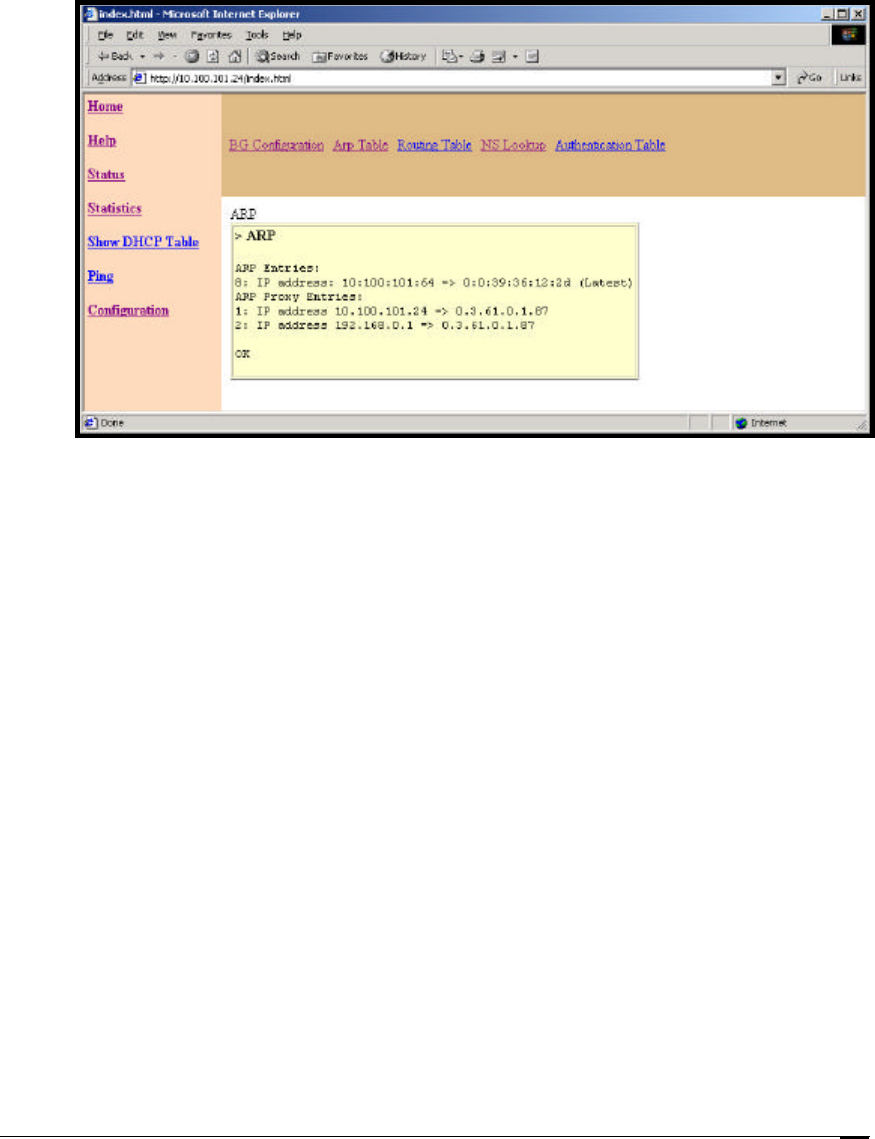
BlueGate 1000 Internal Web Server
May 8, 2001 WIDCOMM, Inc, Proprietary and Confidential 14
6.2.2 ARP Table
The Status > ARP Table internal Web page (Figure 9) displays the active Address
Resolution Protocol (ARP) entries in BlueGate 1000, including:
• Entries for Ethernet devices communicating with BlueGate 1000.
• Proxy entries for Bluetooth devices.
Figure 9: Status > ARP Table internal Web page.
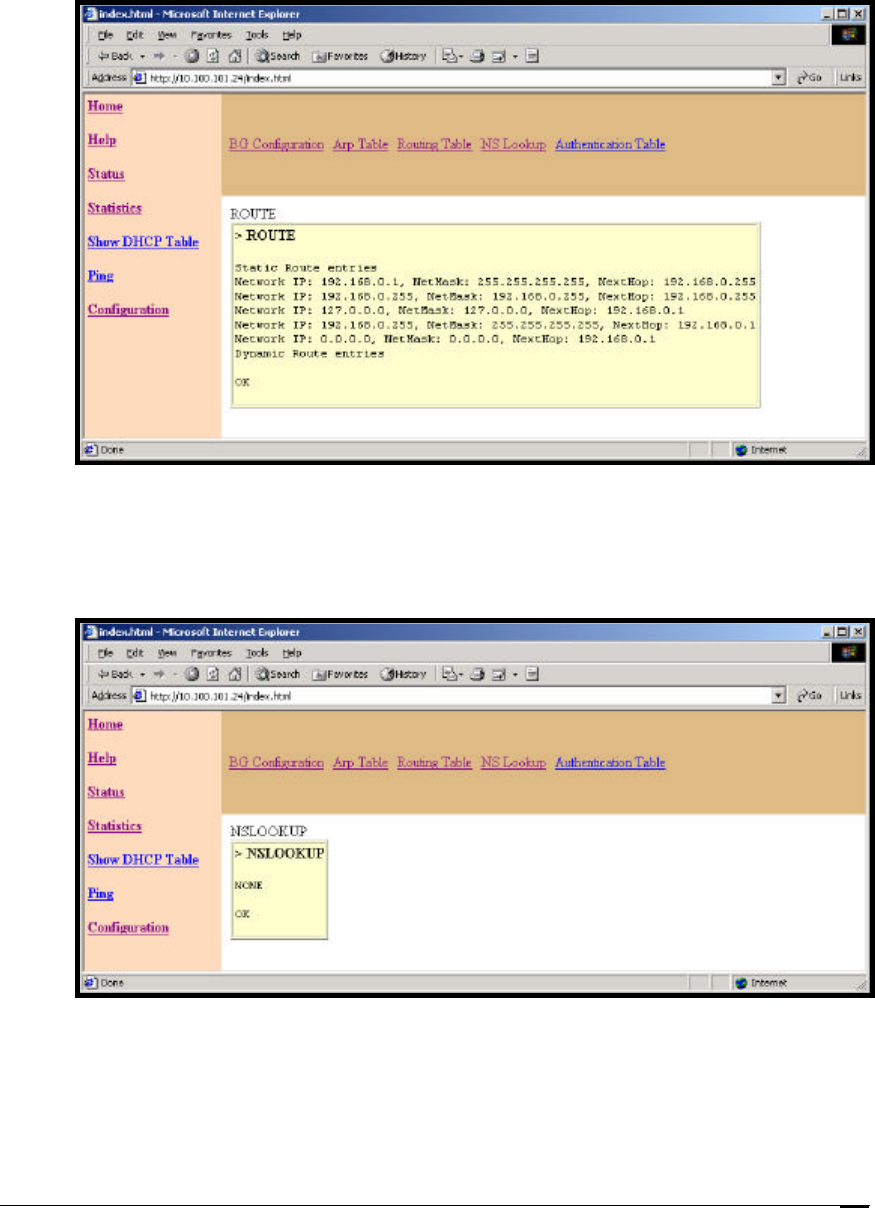
BlueGate 1000 Internal Web Server
May 8, 2001 WIDCOMM, Inc, Proprietary and Confidential 15
6.2.3 Routing Table
The Status > Routing Table internal Web page displays the active routing entries for
loop-back, gateway, and other network node…
Figure 10: Status > Routing Table internal Web page.
6.2.4 NS Lookup
The Status > NS Lookup internal Web page displays recently accessed IP addresses and
the host names associated with them.
Figure 11: Status > DNS Lookup internal Web page.
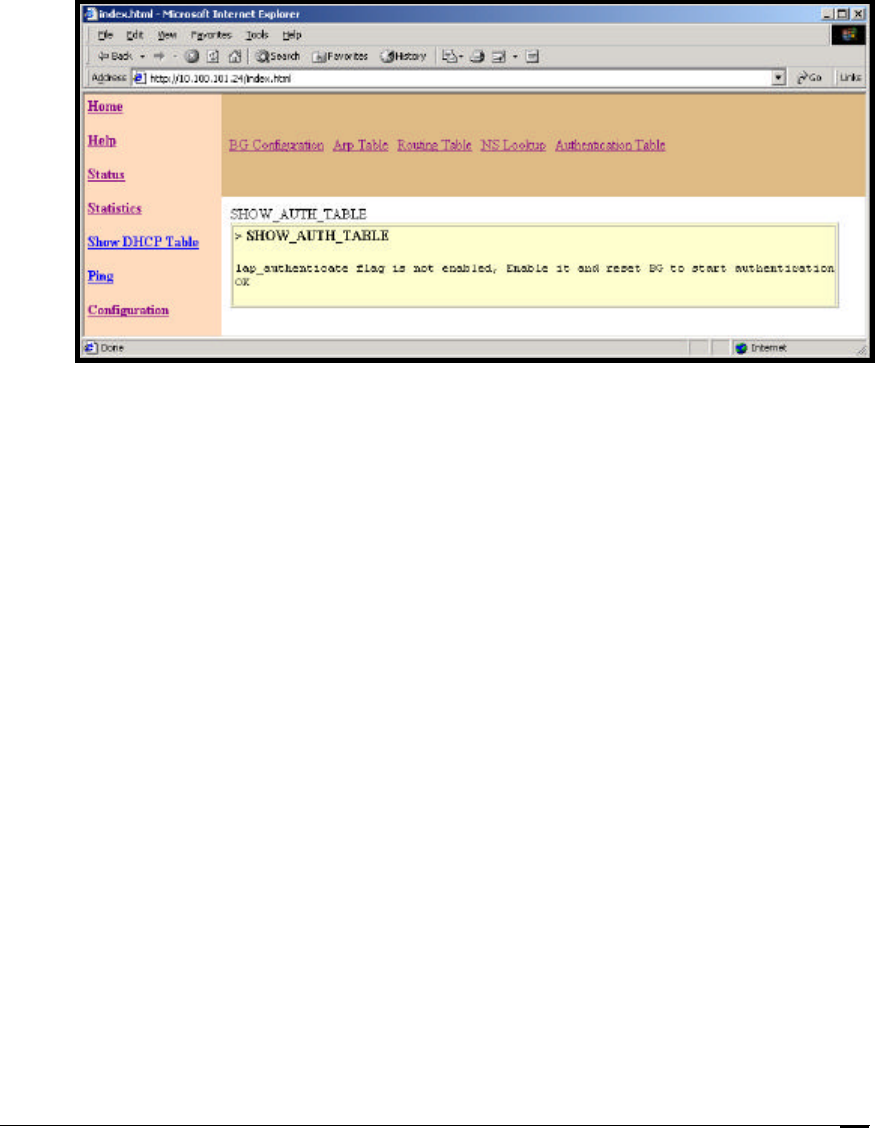
BlueGate 1000 Internal Web Server
May 8, 2001 WIDCOMM, Inc, Proprietary and Confidential 16
6.2.5 Authentication Table
The Status > Authentication Table internal Web page displays the contents of the table
used for Bluetooth security. This table contains the mapping between the Bluetooth
device addresses (BD Addresses) and Bluetooth device attributes, including Pin Code and
Link Key or individual PIN code if authentication is enabled separately for each device;
otherwise it displays the fixed Pin Code if a fixed Pin Code is enabled for all devices.
Figure 12: Status > Authentication Table internal Web page.
6.3 STATISTICS
The statistics hyperlink displays an internal Web page that provides access to additional
Web pages. The additional pages contain read only information related to the network
and the Bluetooth settings of BlueGate 1000.
These functions display a snapshot of network statistics.
• IP—displays network packet counts.
• COM1—reserved for use by WIDCOMM technicians.
• COM2—reserved for use by WIDCOMM technicians.
• MAC—displays framing and error information related to the MAC layer.
• History of Active BT Connections—shows connection statistics.
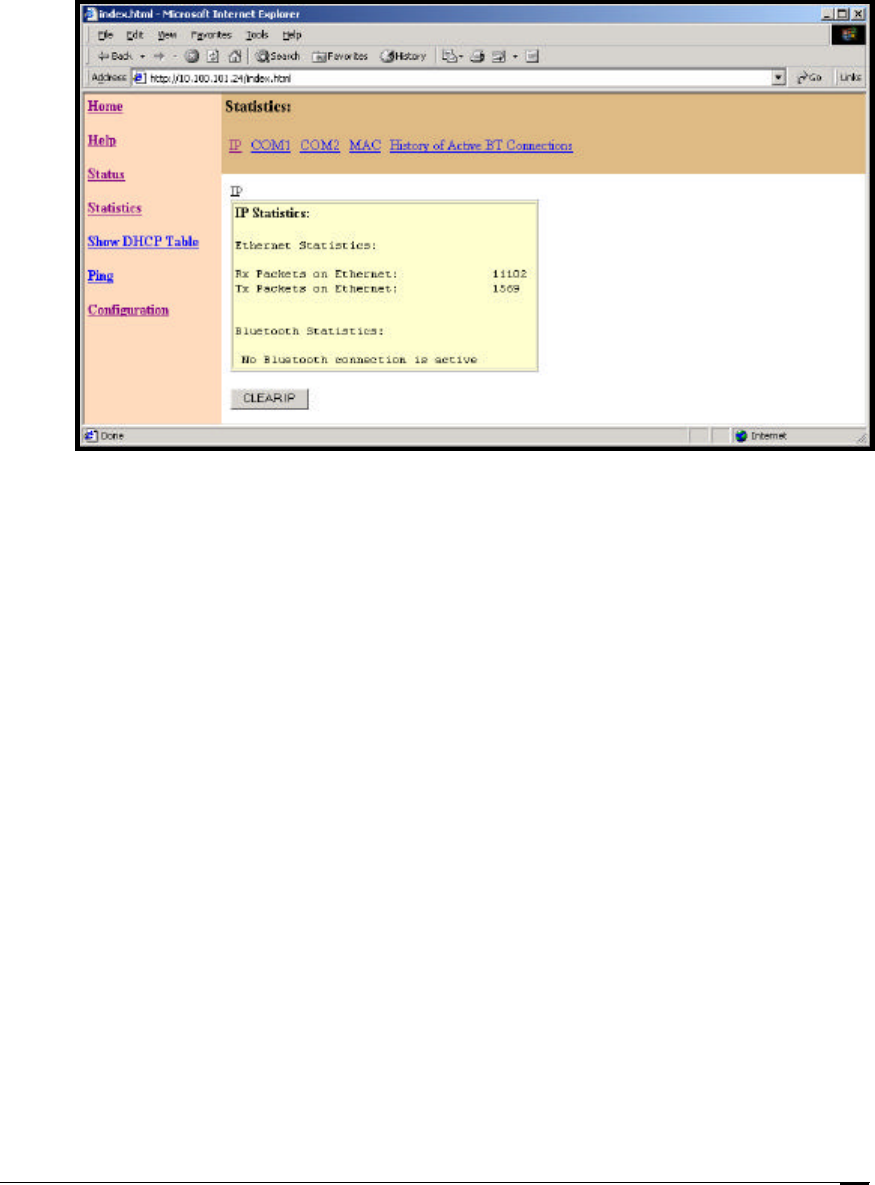
BlueGate 1000 Internal Web Server
May 8, 2001 WIDCOMM, Inc, Proprietary and Confidential 17
6.3.1 IP
The Statistics > IP internal Web page displays the number of IP packets transmitted and
received by BlueGate 1000 on the Ethernet and Bluetooth connections.
The CLEAR IP button resets the counters to zero.
Figure 13: The Statistics > IP internal Web page.
6.3.2 COM1 & COM2
Reserved for use by WIDCOMM technicians.
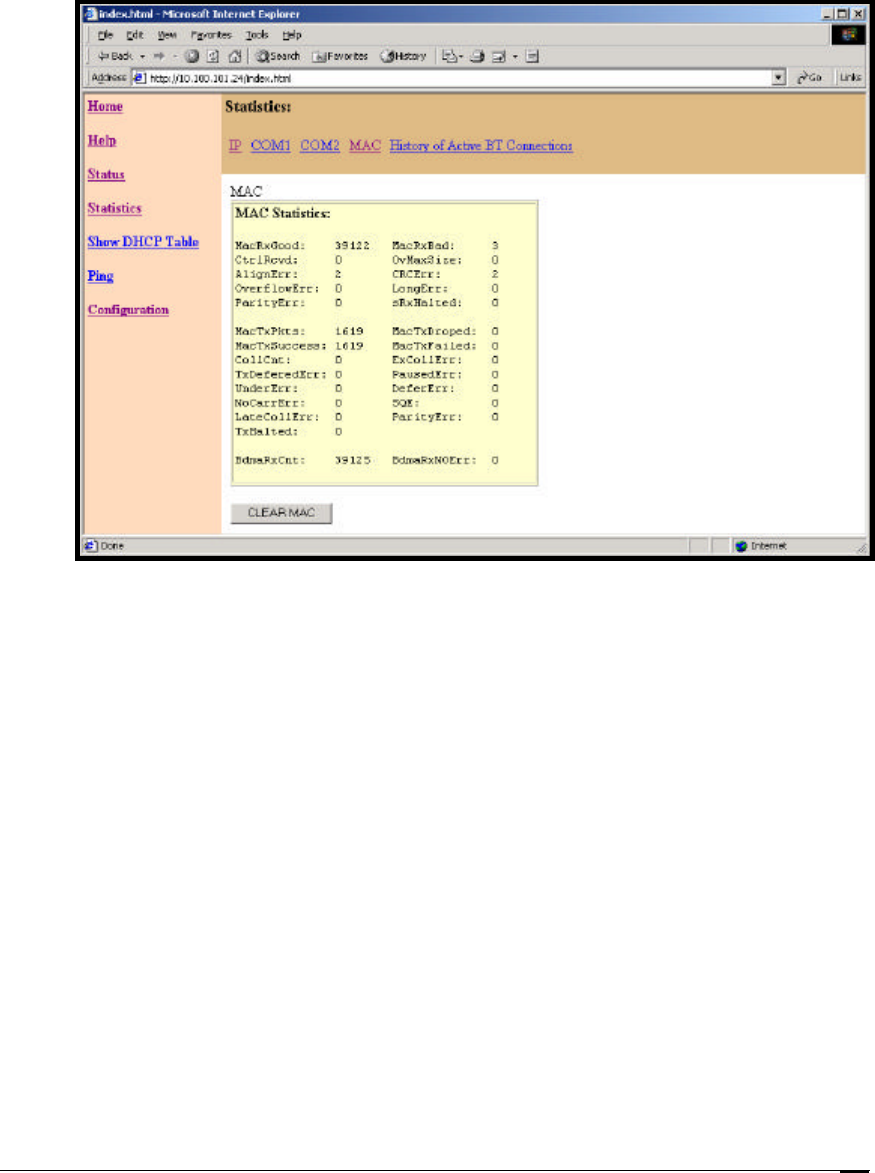
BlueGate 1000 Internal Web Server
May 8, 2001 WIDCOMM, Inc, Proprietary and Confidential 18
6.3.3 MAC
The Statistics > MAC internal Web page displays statistics related to the MAC (Media
Access Control) layer.
The CLEAR MAC button resets the counters to zero.
Figure 14: The Statistics > MAC internal Web page.
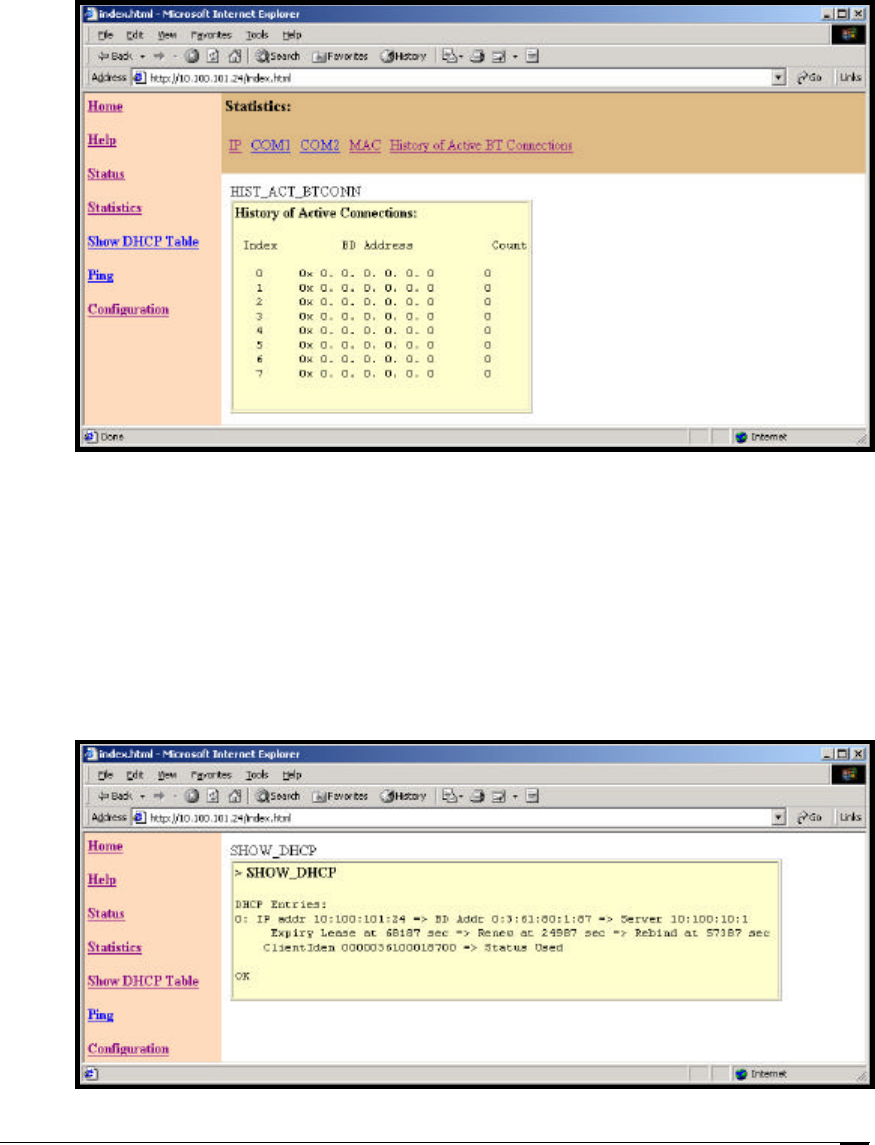
BlueGate 1000 Internal Web Server
May 8, 2001 WIDCOMM, Inc, Proprietary and Confidential 19
6.3.4 History of Active BT Connections
The Statistics > History of Active BT Connections internal Web page displays the
number of times a connection was successful with a particular Bluetooth device address
(BD Address).
The list displays only the eight most recently connected Bluetooth devices.
Figure 15: Statistics > History of Active BT Connections internal Web page.
6.4 SHOW DHCP TABLE
The Show DHCP Table hyperlink displays the IP addresses assigned by the DHCP server
for use by BlueGate 1000 and its clients.
If Network Address Translation (NAT) is enabled this page displays a single entry that
corresponds to IP address of BlueGate 1000.
If NAT is disabled this page displays multiple entries that correspond to BlueGate 1000
and the Bluetooth devices connected to it.
If DHCP is disabled no DHCP entries will exist, regardless of the NAT setting.
Figure 16: The Show DHCP Table internal Web page.
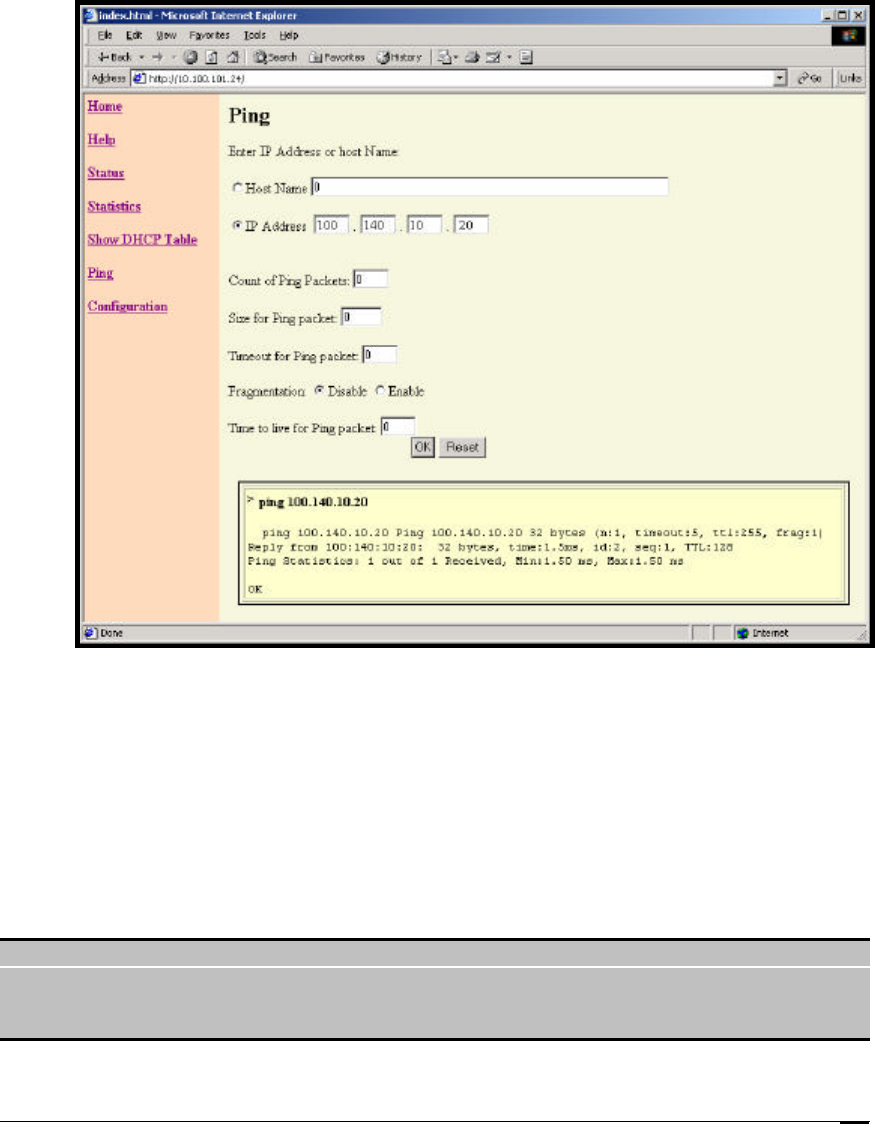
BlueGate 1000 Internal Web Server
May 8, 2001 WIDCOMM, Inc, Proprietary and Confidential 20
6.5 PING
The Ping hyperlink displays an internal Web page that provides a way to send network
packets to a designated network device. The remote device echoes the packets, in the
process providing information about the performance of the network connection.
The OK button executes the ping operation.
The Reset button resets all fields to zero.
Figure 17: The Ping internal Web page and the results (inset) of pinging a remote device.
6.6 CONFIGURE BLUEGATE 1000
The Configuration hyperlink provides access to the internal BlueGate 1000 configuration
Web pages.
A logon screen (Figure 18) appears when “Configuration” is clicked.
To logon:
1. Enter the user name “widcomm”.
2. Enter the password “admin”.
3. Click the OK button to display the Configuration main page.
NOTE: The administrator’s user name and password are re-configurable (see section
6.6.1.4). If they have been changed, enter the appropriate user name and password.
If the new user name and/or password has been lost or forgotten refer to section 4
for information about restoring the defaults.
Select the “Save this password in your password list” option if desired.
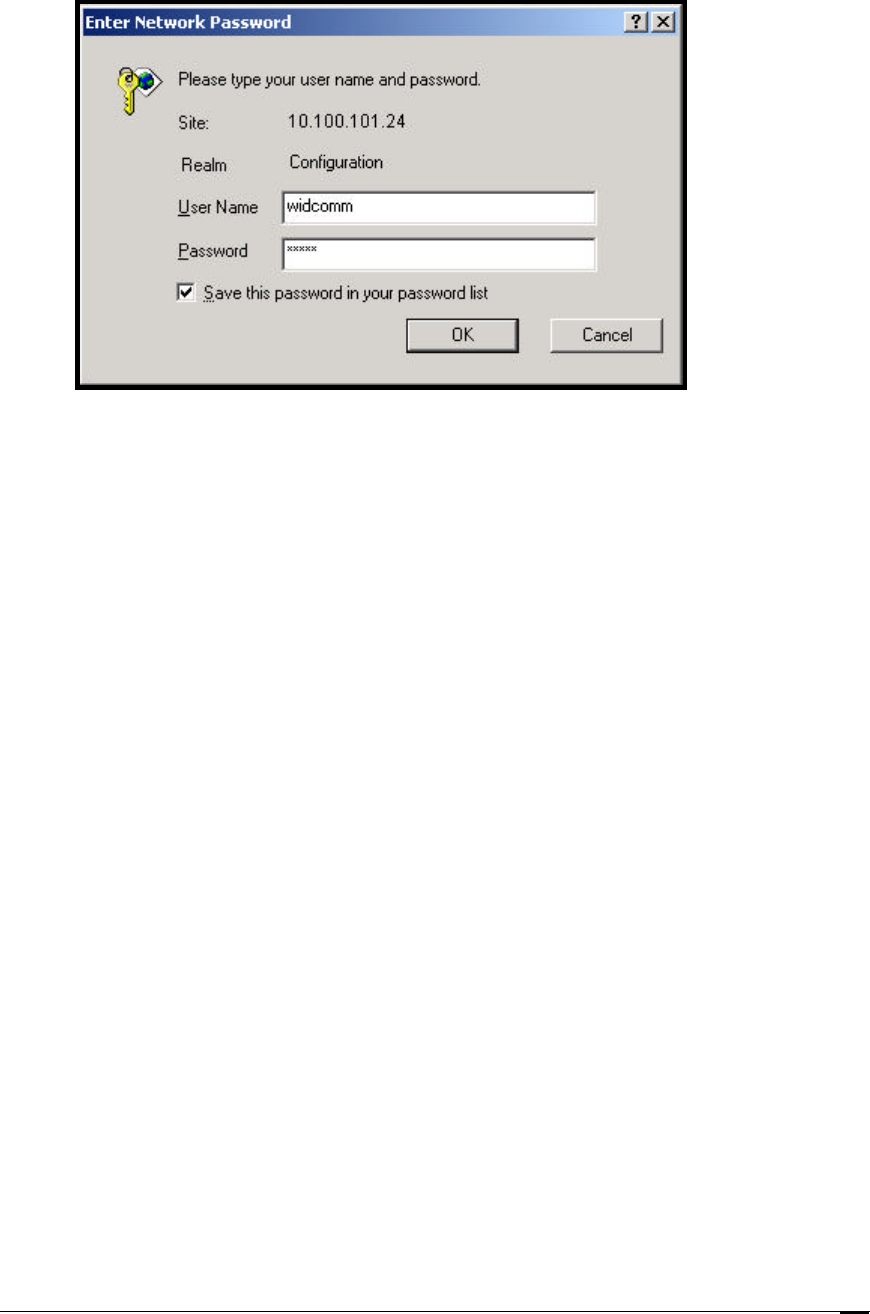
BlueGate 1000 Internal Web Server
May 8, 2001 WIDCOMM, Inc, Proprietary and Confidential 21
Figure 18: The logon screen.
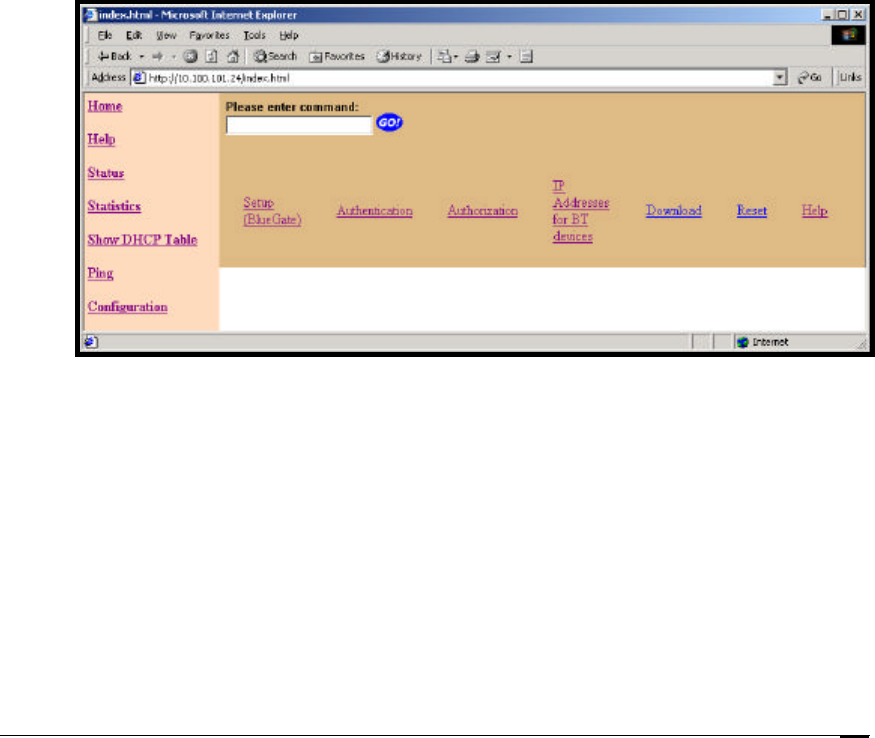
BlueGate 1000 Internal Web Server
May 8, 2001 WIDCOMM, Inc, Proprietary and Confidential 22
6.6.1 Main Page
The Configuration main Web page (Figure 19) contains:
• Please enter command:—an input field used to issue direct commands to the
BlueGate 1000 software engine. See section 7 for command usage and syntax.
• Setup (BlueGate)—displays an internal Web page that provides a means to alter
the configuration of BlueGate 1000.
• Authentication—displays an internal Web page used to configure security
requirements for devices using BlueGate 1000.
• Authorization—displays an internal Web page used to setup the user names and
passwords of authorized Bluetooth users.
• IP Addresses for BT Devices—displays an internal Web page that provides a
means to enter IP addresses in three ranges.
• Download—displays an internal Web page that is used by customer support and
other WIDCOMM technical personnel to download software to BlueGate 1000.
• Reset—Resets BlueGate 1000. This option does not display a separate Web
page; instead a confirmation dialog box is displayed.
• Help—displays a list of commands that can be entered in the “Please enter
command:” field. This option does not display a separate Web page; information
is displayed in the white area of the main window.
Figure 19: The Configuration internal Web page.

BlueGate 1000 Internal Web Server
May 8, 2001 WIDCOMM, Inc, Proprietary and Confidential 23
6.6.1.1 Please Enter Command: Field
The Please enter command input field is used to issue direct commands to the
BlueGate 1000 software engine. Type the command in the field and click “Go” or press
ENTER.
The available commands are described in Section 7.
For a list of available commands type “help” or “?” in the Please enter command field
and click “Go” or press the ENTER key.
6.6.1.2 Setup (BlueGate)
The Configuration > Setup (BlueGate) internal Web page (Figure 20) is used to configure
BlueGate 1000.
Settings can also be modified one at a time with command line parameters using the
Please enter command field. See Sections 6.6.1.1 and 7 for more information.
The available options are:
Bluetooth Settings
• User-friendly Device Name.
• Service Name.
• Encryption.
• Point-to-Multipoint
• Authorization.
• Authentication.
Network Settings
• IP address.
• Gateway.
• Subnet Mask.
• Primary/Secondary DNS Server.
• DHCP Enabled/Disabled.
• NAT Enabled/Disabled.
Make changes to the configuration of BlueGate 1000 by entering information in the fields
and/or selecting radio buttons. Use the TAB key to move between fields.
Click the Update button to store the changes in BlueGate 1000’s non-volatile memory.
The updated configuration is displayed in the white area of the Configuration > Setup
Web page) and reflected on the Status > BG Configuration (Figure 8) Web page.
For the changes to take affect BlueGate 1000 must be reset (see Section 4).
NOTE: Setup changes do not take affect until BlueGate 1000 is reset.

BlueGate 1000 Internal Web Server
May 8, 2001 WIDCOMM, Inc, Proprietary and Confidential 24
6.6.1.2.1 Device Name
The device name is used to help identify BlueGate 1000 to other Bluetooth devices. It is
limited in length to 100 characters.
To change the Device Name, highlight the existing text and type the new name.
Example : My BlueGate Network Access Point.
6.6.1.2.2 Service Name
The Service Name is the name for the LAN Access Profile service that BlueGate 1000
displays to remote devices. It is limited in length to 100 characters.
The default service for the LAN Access Profile is “LOCAL LAN”.
To change the Service Name, highlight the existing text and type the new name.
Example : LAN Access.
6.6.1.2.3 IP Addr
IP Addr is the IP address of BlueGate 1000. This box contains two fields:
• Active IP Addr: the IP address in use by the BlueGate 1000.
§ If DHCP is enabled, this is the address assigned to BlueGate 1000 by the
network DHCP server the last time BlueGate 1000 was started or reset.
§ If DHCP is disabled, this is the fixed IP address that was in non-volatile
memory the last time BlueGate 1000 was started or reset.
• Stored NV IP Addr: the fixed IP address in BlueGate 1000's non-volatile
memory. When DHCP is disabled this address is used by BlueGate 1000 as its IP
address.
To change the fixed IP address:
§ Highlight the existing address and type the new one in dotted decimal
notation.
§ Click the Update button.
§ Reset BlueGate 1000.
Example: 192.168.0.50
NOTE: Changes to values stored in NVRAM do not take affect until BlueGate 1000 is reset.

BlueGate 1000 Internal Web Server
May 8, 2001 WIDCOMM, Inc, Proprietary and Confidential 25
6.6.1.2.4 Gateway
Gateway is the IP address of the LAN gateway to which BlueGate 1000 will route
packets destined for outside networks. This box contains two fields:
• Active Gateway Addr: the gateway address in use by BlueGate 1000.
§ If DHCP is enabled, it is the address provided to the BlueGate 1000 by the
network's DHCP server the last time BlueGate 1000 was started or reset.
§ If DHCP is disabled, this is the fixed gateway address that was in non-
volatile memory the last time BlueGate 1000 was started or reset.
• Stored NV Gateway Addr: the fixed gateway address stored in BlueGate 1000's
non-volatile memory. If DHCP is disabled this address is used to determine
BlueGate 1000's gateway address at startup.
To change the gateway address:
§ Highlight the existing address and type the new one in dotted decimal
notation.
§ Click the Update button.
§ Reset BlueGate 1000.
Example: 100.140.0.1
6.6.1.2.5 Subnet Mask
The Subnet Mask is used to identify the subnet to which an IP address belongs. This box
contains two fields:
• Active Subnet Mask: the subnet mask in use by BlueGate 1000.
§ If DHCP is enabled it is the subnet mask provided by the network DHCP
server the last time BlueGate 1000 was started or reset.
§ If DHCP is disabled, this is the fixed subnet mask that was in non-volatile
memory the last time BlueGate 1000 was started or reset.
• Stored NV Subnet Mask: the fixed subnet mask stored in BlueGate 1000's
non-volatile memory. If DHCP is disabled this address is used to determine
BlueGate 1000's subnet mask at startup.
To change the subnet mask:
§ Highlight the existing subnet mask and type the new one in dotted decimal
notation.
§ Click the Update button.
§ Reset BlueGate 1000.
Example: 255.255.255.0

BlueGate 1000 Internal Web Server
May 8, 2001 WIDCOMM, Inc, Proprietary and Confidential 26
6.6.1.2.6 Primary DNS
Primary DNS is the IP address of the primary Domain Name System server. When a
DNS server is provided with a "hostname", it returns the host's IP address. This box
contains two fields.
• Active Primary DNS: the IP address of the primary DNS server in use by
BlueGate 1000.
§ If DHCP is enabled, it is the primary DNS server provided the network
DHCP server the last time BlueGate 1000 was started or reset.
§ If DHCP is disabled, this is the fixed IP address of the primary DNS server
that was in non-volatile memory the last time BlueGate 1000 was started or
reset.
• Stored NV Primary DNS: the IP address for primary DNS server stored in
BlueGate 1000's non-volatile memory. If DHCP is disabled this address is used
to determine the BlueGate 1000's primary DNS server at startup. To change the
Primary DNS address:
§ Highlight the existing address and type the new one in dotted decimal
notation.
§ Click the Update button.
§ Reset BlueGate 1000.
Example: 100.140.10.1
6.6.1.2.7 Secondary DNS
Secondary DNS is the IP address of the secondary Domain Name System server. The
secondary DNS server is used if the primary DNS server is either unavailable or unable
to translate a submitted host name to an IP address. This box contains two fields.
• Active Secondary DNS: the IP address of the secondary DNS server in use by
BlueGate 1000.
§ If DHCP is enabled, it is the secondary DNS server provided to by the
network's DHCP server the last time BlueGate 1000 was started or reset.
§ If DHCP is disabled, this is the fixed IP address of the secondary DNS server
that was in non-volatile memory the last time BlueGate 1000 was started or
reset.
• Stored NV Secondary DNS: the IP address for the secondary DNS server that
isstored in BlueGate 1000's non-volatile memory. If DHCP is disabled this
address is used to determine BlueGate 1000's secondary DNS server at startup.
To change the Secondary DNS address:
§ Highlight the existing address and type the new one in dotted decimal
notation.
§ Click the Update button.
§ Reset BlueGate 1000.
Example: 100.140.10.1

BlueGate 1000 Internal Web Server
May 8, 2001 WIDCOMM, Inc, Proprietary and Confidential 27
6.6.1.2.8 DHCP
DHCP (Dynamic Host Configuration Protocol) automatically assigns IP addresses on a
network.
Enable/disable DHCP by clicking the appropriate radio button.
• When DHCP is enabled, BlueGate 1000’s IP address is obtained from the DHCP
server.
• When DHCP is disabled, fixed IP addresses are read from BlueGate 1000’s
on-board NVRAM.
NOTE: If DHCP is enabled BlueGate 1000 ignores the IP address(es) stored in its NVRAM.
6.6.1.2.9 NAT
NAT (Network Address Translation) is an Internet standard that allows a network to use
one set of IP addresses for internal traffic and a different set of addresses for external
traffic.
BlueGate 1000 handles address translations between the LAN (external) and the
Bluetooth devices (internal) connected to BlueGate 1000.
Enable/disable NAT by clicking the appropriate radio button.
• If NAT is enabled, BlueGate 1000 automatically assigns an IP address to each
connected Bluetooth device.
• If NAT is disabled and:
§ DHCP is enabled, Bluetooth devices get their IP address from the DHCP
server.
§ DHCP is disabled, the IP address for each Bluetooth device must be
configured in BlueGate 1000’s NVRAM.
The table at the bottom of the Configuration > Setup (BlueGate) internal Web page
shows the possible combinations of DHCP and NAT enabled/disabled.
6.6.1.2.10 Encryption
Encryption is the translation of data into a secret code. Encryption is a link-level security
feature of Bluetooth; it requires no user input.
When enabled, encryption only applies to data transferred between Bluetooth devices—
data transferred via the network is not encrypted.
To enable encryption, authentication must also be enabled. If authentication is not
enabled, the encryption setting is ignored and the connection is not encrypted.
Enable/disable Encryption by clicking the appropriate radio button.
NOTE: Do not enable Encryption if the connecting device does not support security.
6.6.1.2.11 Point-to-Multipoint
Point-to-Multipoint refers to the ability of a device to connect to more than one remote
device at the same time.
BlueGate 1000’s point-to-multipoint ability, when enabled, is limited to seven devices.
To enable/disable point-to-multipoint click the appropriate radio button.

BlueGate 1000 Internal Web Server
May 8, 2001 WIDCOMM, Inc, Proprietary and Confidential 28
6.6.1.2.12 Authorization
Authorization is part of the process of granting or denying access to a resource. A user
name and password are required.
Computer security systems are frequently based on a two-step process:
• Authentication ensures that a user is who he claims to be.
• Authorization allows access to resources, based on the user's identity
If authorization is disabled, all users are allowed to connect to BlueGate 1000.
If authorization is enabled, only specific users can connect to BlueGate 1000.
See Section 6.6.1.4 for information on how to configure user authorization.
NOTE: Do not enable Authorization if the connecting device does not support security.
6.6.1.2.13 Authentication
Authentication is part of the process of granting or denying access to a resource.
Computer security systems are frequently based on a two-step process:
• Authentication ensures that a user is who he claims to be.
• Authorization allows access to resources, based on the user's identity.
Authentication, in this context, applies only to access to BlueGate 1000; it does not
necessarily permit access to any higher-level network services.
If authentication is disabled, all Bluetooth devices are allowed to connect to
BlueGate 1000.
If authentication is enabled:
• A single fixed Pin Code may be used for all devices.
• A different Pin Code may be used for each device.
See Section 6.6.1.3 for more information on how to configure authentication.
Enabling authentication generates a link key for each device. Link keys are based on the
PIN code and the Bluetooth device address.
NOTE: Do not enable Authentication if the connecting device does not support security.
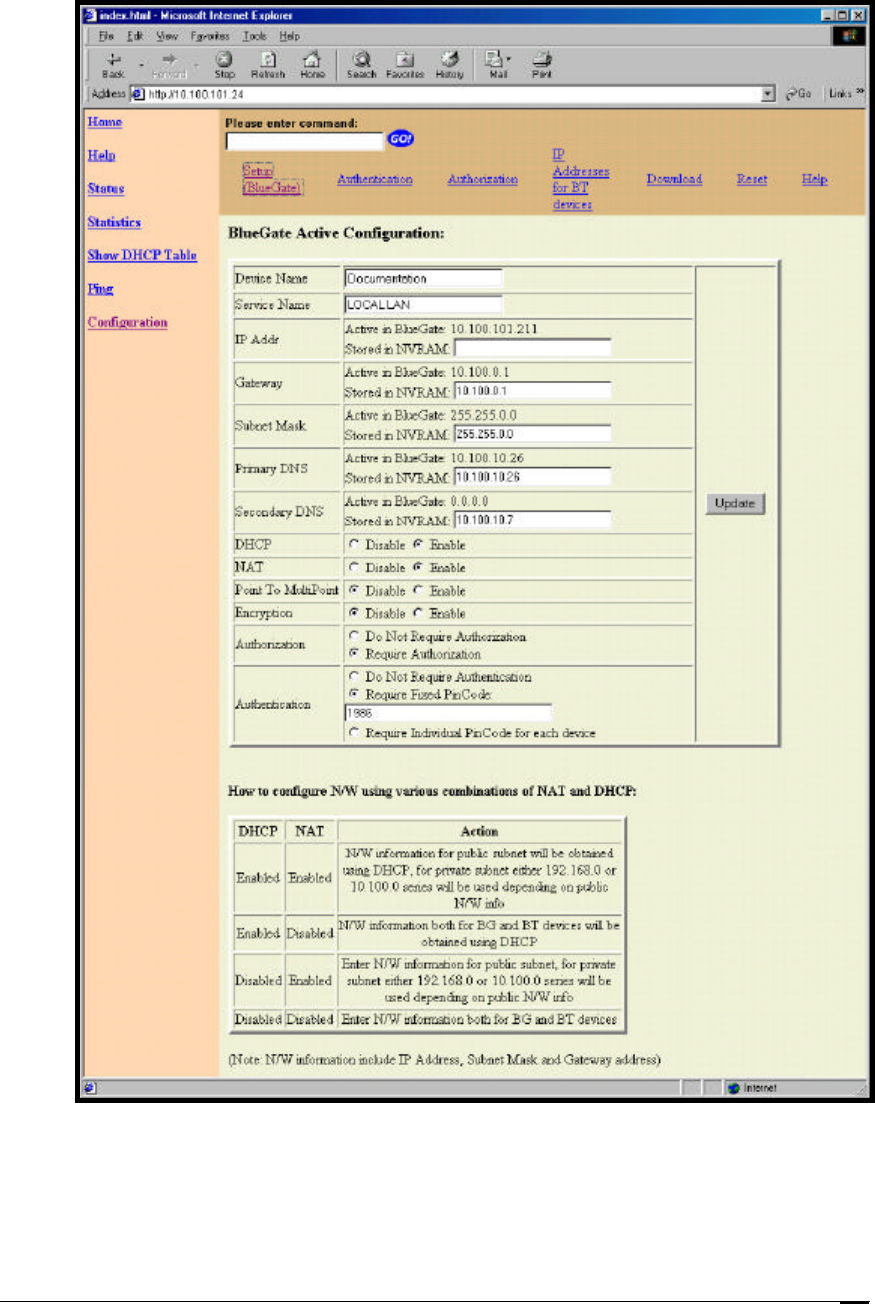
BlueGate 1000 Internal Web Server
May 8, 2001 WIDCOMM, Inc, Proprietary and Confidential 29
Figure 20: The Configuration > Setup (BlueGate) internal Web page.
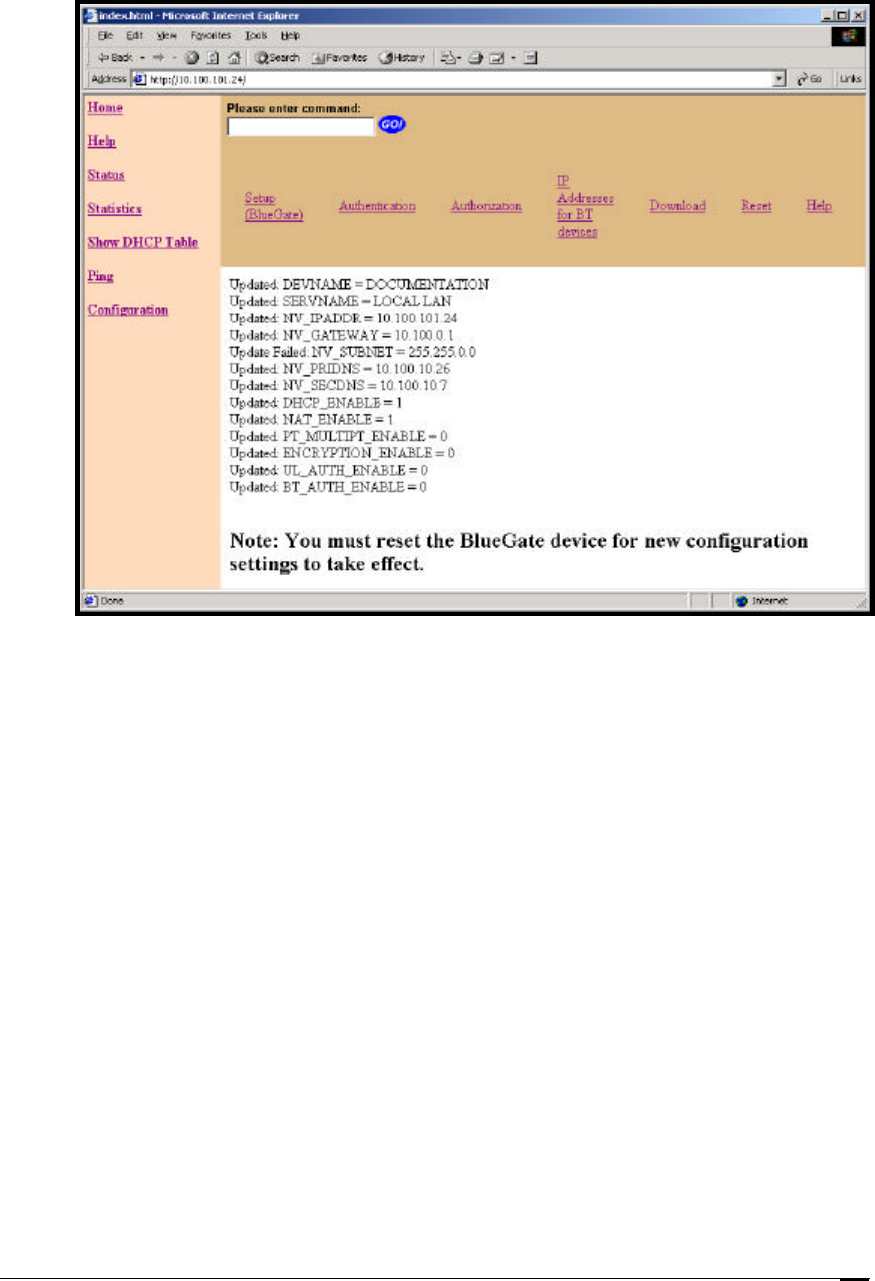
BlueGate 1000 Internal Web Server
May 8, 2001 WIDCOMM, Inc, Proprietary and Confidential 30
Figure 21: The Configuration > Setup (BlueGate) update page appears when the “Update”
button is pressed to implement changes from the setup page.
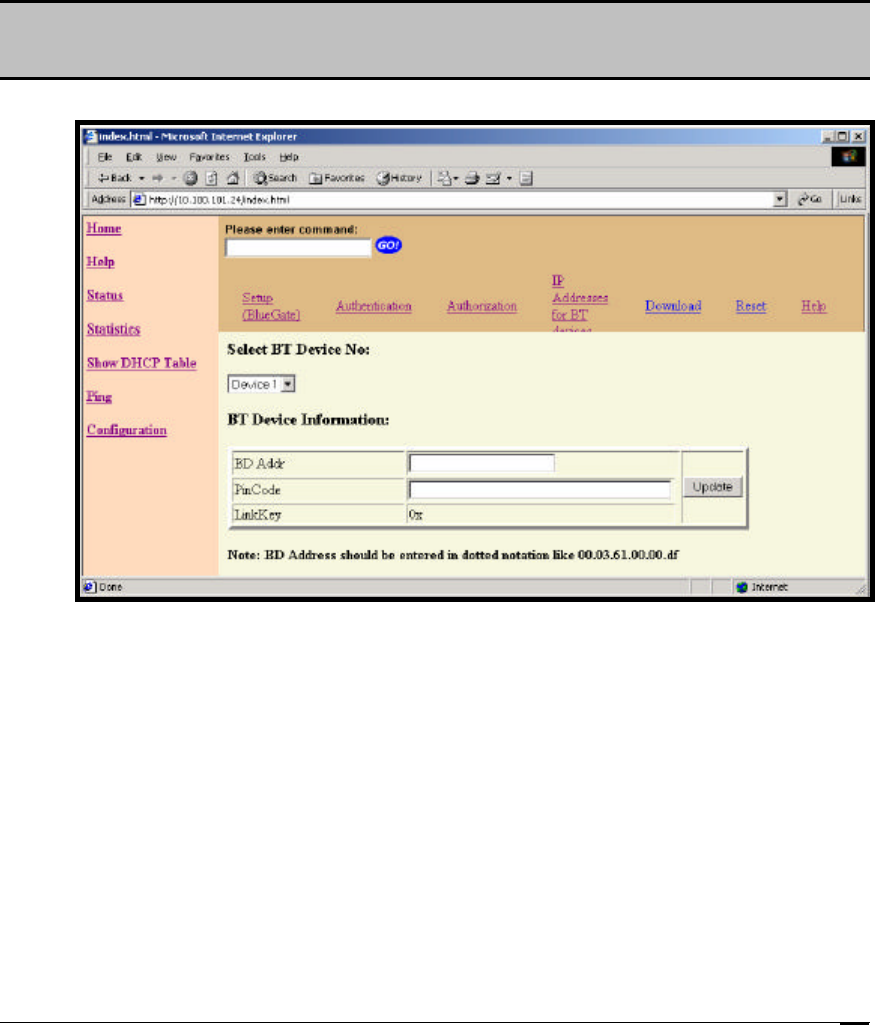
BlueGate 1000 Internal Web Server
May 8, 2001 WIDCOMM, Inc, Proprietary and Confidential 31
6.6.1.3 Authentication
The Configuration > Authentication internal Web page provides a way to enter security
settings for Bluetooth devices that use BlueGate 1000 to access the local area network.
A different Personal Identification Number (Pin Code) can be assigned to each of up to
seven Bluetooth devices.
• To enter a Pin Code for an individual device.
§ Select the device number in the Select BT Device No drop-down menu.
§ Enter the Bluetooth Device Address in the BD Addr field.
§ Enter the Pin Code in the PinCode field.
§ Click the Update button.
NOTE: Individual PIN codes are only used if “Require individual PinCode for each device”
is selected on the Configuration > Setup (BlueGate) internal Web page (see
Section 6.6.1.2.13).
Figure 22: The Configuration > Authentication internal Web page.
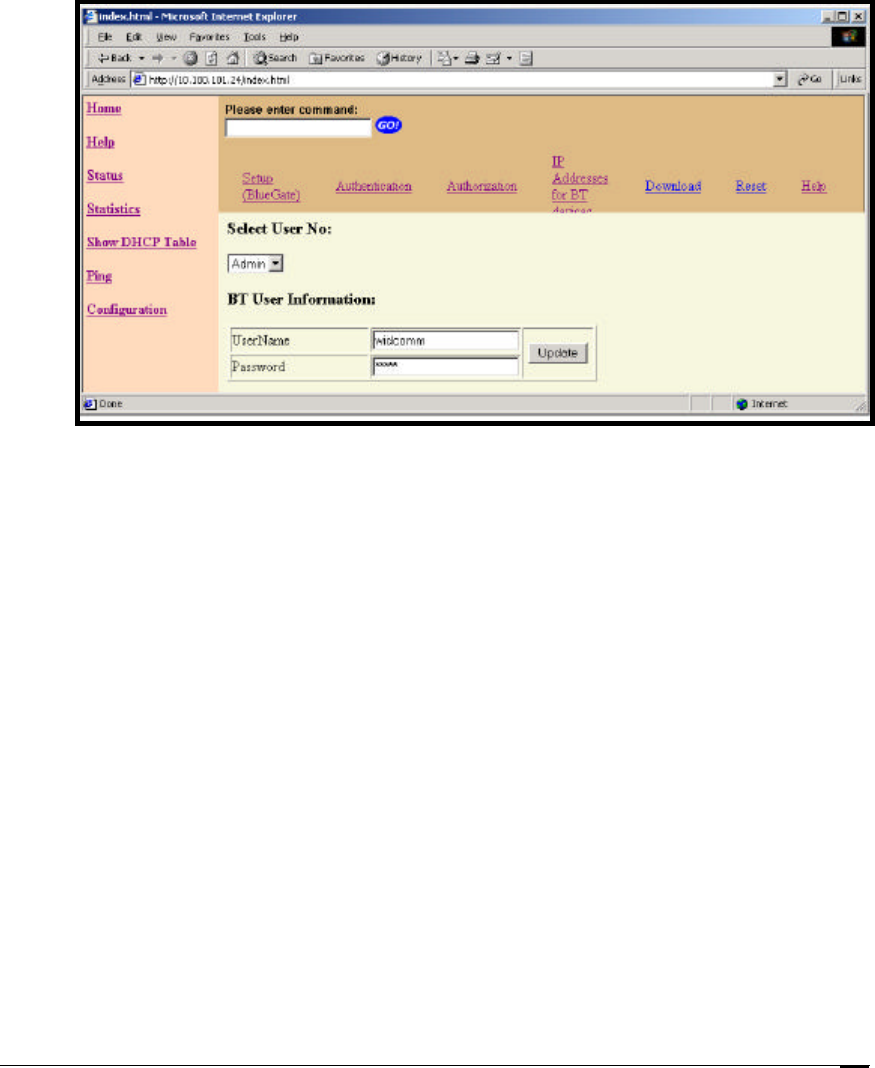
BlueGate 1000 Internal Web Server
May 8, 2001 WIDCOMM, Inc, Proprietary and Confidential 32
6.6.1.4 Authorization
The Configuration > Authorization internal Web page provides a way to enter user names
and passwords for each authorized Bluetooth user. In addition to the administrator, up to
seven users can be entered.
User names and passwords are case sensitive; if “Tony” is the valid password and “tony”
is entered, access will be denied.
The first item in the drop-down list, “Admin”, contains the user name and password that
is allowed to access the BlueGate 1000 internal Web server.
Figure 23: The Configuration > Authorization internal Web page.

BlueGate 1000 Internal Web Server
May 8, 2001 WIDCOMM, Inc, Proprietary and Confidential 33
6.6.1.5 IP Addresses for BT devices.
The Configuration > IP Addresses for BT devices internal Web page is used to specify
three IP address ranges and the number of addresses in each range. Together, these
addresses form an address pool from which BlueGate 1000’s internal DHCP server
allocates IP addresses to connecting Bluetooth devices.
Note: These IP addresses are only used when DHCP and NAT are both disabled (see
Sections 6.6.1.2.8 and 6.6.1.2.9).
Valid IP addresses must be in the same subnet as BlueGate 1000.
To enter an IP address range:
1. Type the beginning IP address, in dotted decimal notation, in the Range Starting
From field.
2. Enter the number of IP address to allocate in the No. of IP Addresses in this
range field.
3. Click the Update button
4. Reset the BlueGate 1000 (see section 4).
Example:
• Range Starting From = 192.168.1.20
and
• No. of IP Addresses in this range = 5
generates a pool of five IP addresses, beginning with 192.168.1.20 and ending
with 192.168.1.24.
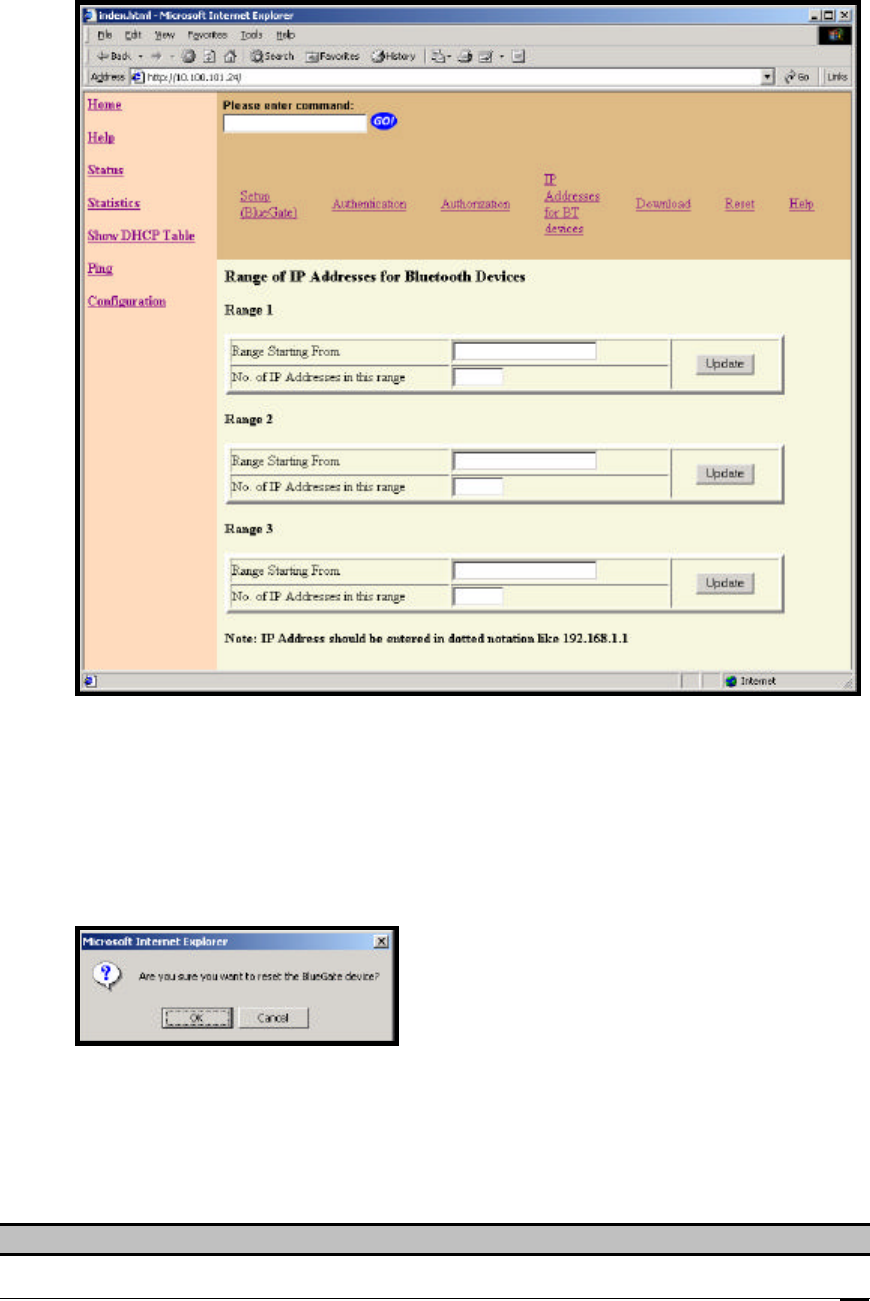
BlueGate 1000 Internal Web Server
May 8, 2001 WIDCOMM, Inc, Proprietary and Confidential 34
Figure 24: Configuration > IP Addresses for BT devices internal Web page.
6.6.1.6 Download
This internal Web page is reserved for use by WIDCOMM support personnel.
6.6.1.7 Reset
To reset BlueGate 1000 click the Reset hyperlink.
An Internet Explorer confirmation dialog box appears (Figure 25).
Click OK in the dialog box to reset BlueGate 1000.
Figure 25: The Configuration > Reset confirmation dialog box.
The internal Web page shown in Figure 26 appears. Click the IP address hyperlink after
ten seconds to return to BlueGate 1000’s internal home page.
When BlueGate 1000 is reset it disconnects from the DHCP server.
The server may assign a different IP address to BlueGate 1000 when it reconnects. If this
happens run the Java applet BGIPLookup.html to discover the new IP address assigned to
BlueGate 1000.
NOTE: See Section 4 for additional information about resetting BlueGate 1000.
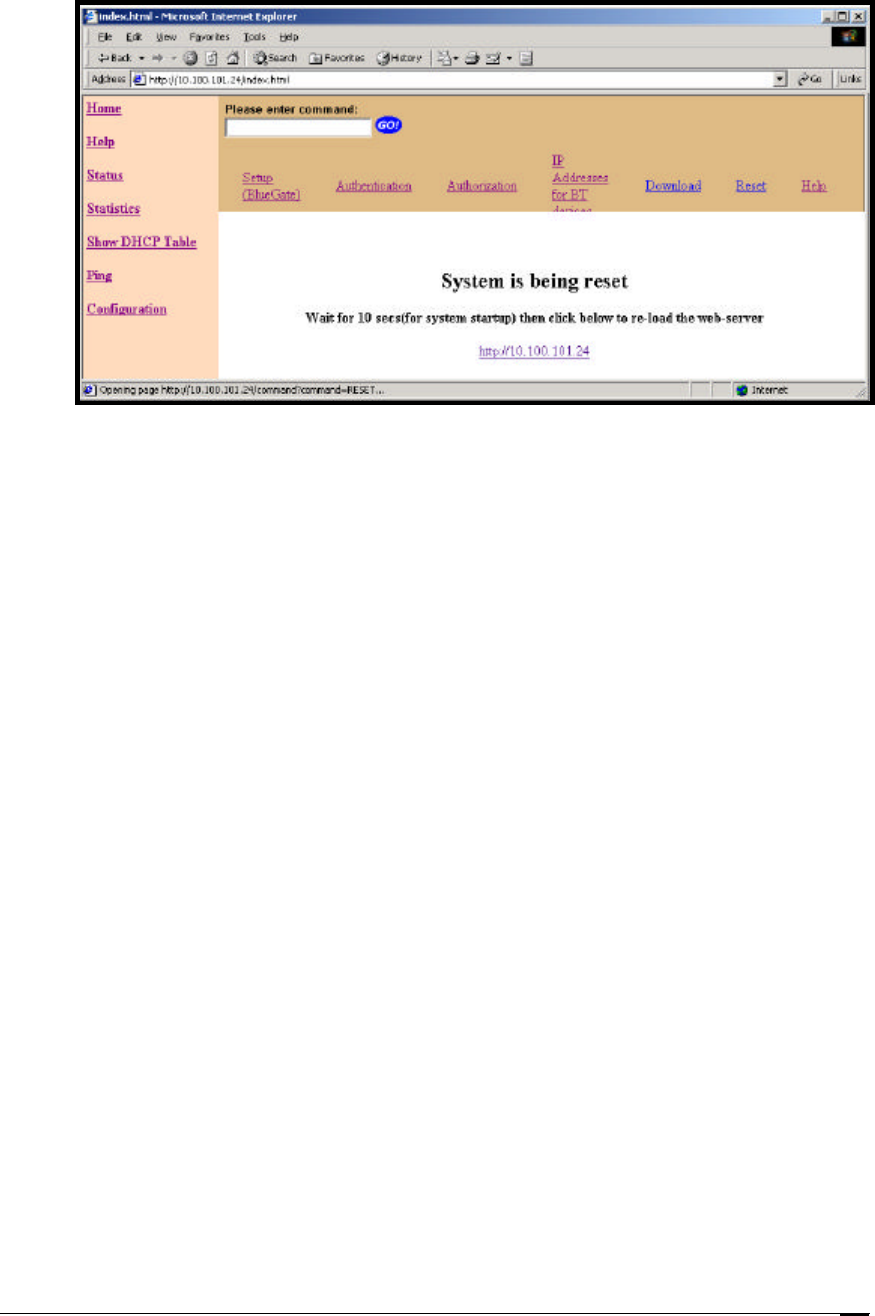
BlueGate 1000 Internal Web Server
May 8, 2001 WIDCOMM, Inc, Proprietary and Confidential 35
Figure 26: The internal Web page that appears after confirming a system reset.
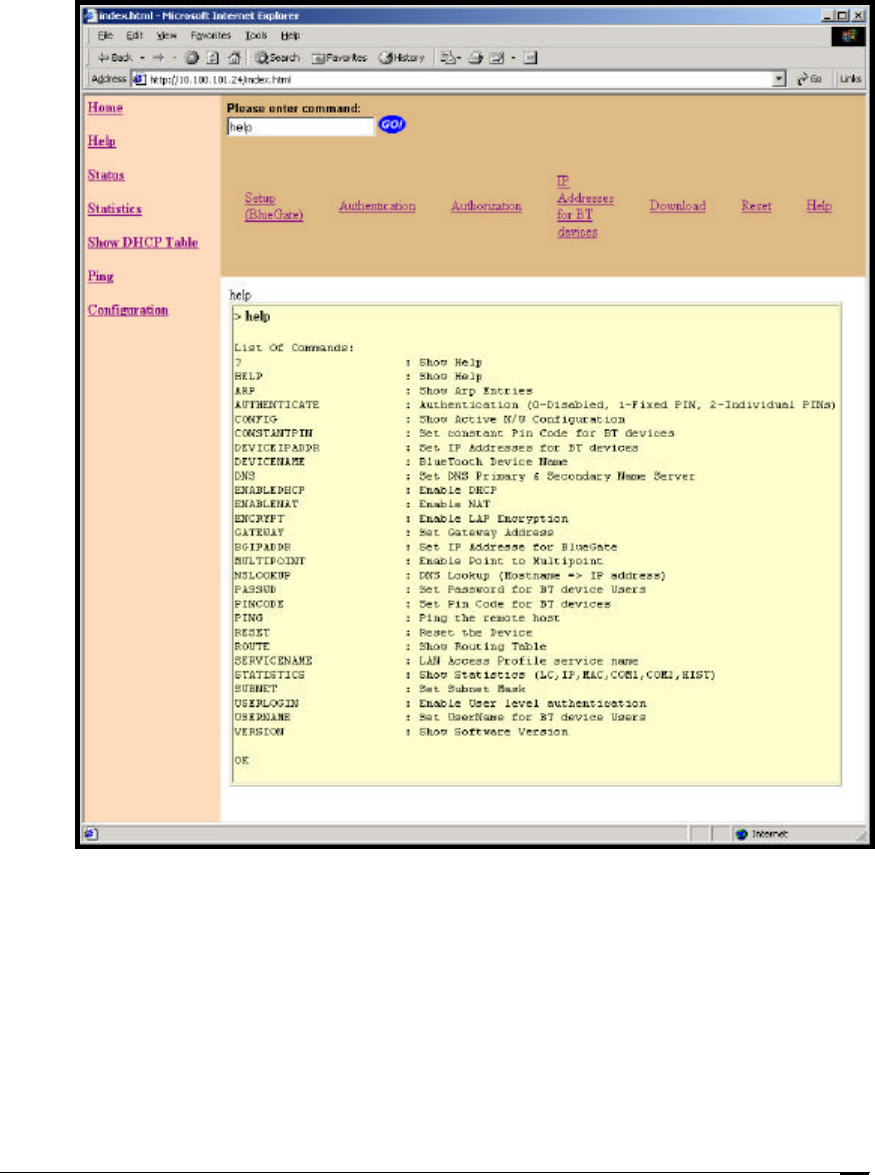
BlueGate 1000 Internal Web Server
May 8, 2001 WIDCOMM, Inc, Proprietary and Confidential 36
6.6.1.8 Help
The Configuration > Help internal Web page displays a list of commands that can be
entered directly into the “Please enter command” field.
For information about how to use these commands see Section 7.
Figure 27: The Configuration > Help internal Web page.

BlueGate 1000 Command Line Entry
May 8, 2001 WIDCOMM, Inc, Proprietary and Confidential 37
7 Command Line Entry
Commands may be entered directly into the Please enter command field.
Many of the available commands accept parameters. When a command is entered without
parameters, the current setting(s) for that command are displayed; exceptions to this
general rule are noted on a command-by-command basis in the remainder of this section.
All commands in this section are also available via the hyperlinks on BlueGate 1000
internal Web pages.
When a command and its associated parameters are entered, a confirmation dialog box
appears in the information pane of the Internet Explorer window.
NOTE: BlueGate 1000 must be reset for configuration changes to take affect.
7.1 ? OR HELP
Displays a list of the commands that may be entered in the Please enter command field
and provides a brief description of each command.
7.2 ARP
Displays the active Address Resolution Protocol (ARP) table entries for BlueGate 1000.
7.3 AUTHENTICATE
Sets the authentication level.
Format: AUTHENTICATE = n
n is 0, 1 or 2:
• 0 disables authentication.
• 1 enables the use of a fixed Pin Code for all devices.
• 2 enables the use of an individual Pin Code for each device.
Example: AUTHENTICATE = 0
7.4 CONFIG
Displays the active configuration of BlueGate 1000.
7.5 CONSTANTPIN
Sets the fixed Pin Code to be used by all Bluetooth devices attempting to access
BlueGate 1000. The Pin Code can be up to 16 characters long.
Format: CONSTANTPIN = ASCII string
• ASCII string is the actual Pin Code.
Example: CONSTANTPIN = 2233
NOTE: Do not use CONSTANTPIN if the connecting device does not support security.

BlueGate 1000 Command Line Entry
May 8, 2001 WIDCOMM, Inc, Proprietary and Confidential 38
7.6 DEVICEIPADDR
Sets the IP address ranges for Bluetooth Devices if DHCP is disabled.
Format: DEVICEIPADDR = n,cnt,aa.bb.cc.dd
• n is the range number: range1, range 2,or range 3.
• cnt is the number of IP addresses.
• aa.bb.cc.dd is the starting IP address in dotted decimal notation.
Example: DEVICEIPADDR = 1,3,192.168.0.1 generates a pool of three IP addresses
(192.168.0.1, 192.168.0.2, and 192.168.0.3) in range one on BlueGate 1000.
7.7 DEVICENAME
Sets the user-friendly device name of BlueGate 1000. The device name helps identify
BlueGate 1000 to other devices; the name can be up to 100 characters in length.
Format: DEVICENAME = ASCII string
• ASCII string is the actual user-friendly name of the device.
Example: DEVICENAME = My BlueGate Network Access Point
7.8 DNS
Sets the Domain Name System (DNS) Primary & Secondary Server IP addresses.
Format: DNS = n,aa.bb.cc.dd
• n is 0 or 1
§ 0 sets the primary DNS server IP address.
§ 1 sets the secondary DNS server IP address.
• aa.bb.cc.dd is the IP address, in dotted decimal notation.
Examples: DNS = 0,100.140.10.1 sets the Primary DNS server IP address
to 100.140.10.1.
DNS = 1,100.140.10.2 sets the Secondary DNS server IP address
to 100.140.10.2.
7.9 ENABLEDHCP
Enables/disables Dynamic Host Configuration Protocol (DHCP).
Format: ENABLEDHCP = n
• n is 0 or 1:
§ 1 enables DHCP.
§ 0 disables DHCP.
Example: ENABLEDHCP = 1
7.10 ENABLENAT
Enables/disables the Network Address Translation (NAT).
Format: ENABLENAT = n
• n is 0 or 1:
§ 1 enables NAT.
§ 0 disables NAT.

BlueGate 1000 Command Line Entry
May 8, 2001 WIDCOMM, Inc, Proprietary and Confidential 39
Example: ENABLENAT = 1
7.11 ENCRYPT
Enables/disables LAN Access Profile (LAP) Encryption.
Format: ENCRYPT = n
• n is 0 or 1:
§ 1 enables Encryption.
§ 0 disables Encryption.
Example: ENCRYPT = 1
7.12 GATEWAY
Displays the IP address of the LAN gateway to which BlueGate 1000 is connected.
Format: GATEWAY = aa.bb.cc.dd
• aa.bb.cc.dd is the dotted decimal notated IP address of the LAN gateway.
Example: GATEWAY = 192.168.1.1
7.13 IPADDR
Sets the IP address of BlueGate 1000. It is only used when DHCP is disabled.
Format: IPADDR = n,aa.bb.cc.dd
• n must be 0.
• aa.bb.cc.dd is the dotted decimal notated IP address of BlueGate 1000.
Example: IPADDR = 0,192.168.0.50
7.14 MULTIPOINT
Enables/disables point-to-multipoint.
Format: Multipoint = n
• n is 0 or 1:
§ 1 enables point-to-multipoint.
§ 0 disables point-to-point.
Example: Multipoint = 1
7.15 NSLOOKUP
Displays the DNS lookup table i.e. mapping of HostName to IP addresses Format:
Format: NSLOOKUP = valid hostname
Example: NSLOOKUP = www.yahoo.com
7.16 PASSWD
Sets the password for the administrator and individual remote users. Password length is
limited to 16 characters.
Format: PASSWD = n,ASCII string
• n is a number zero to six.
• ASCII string is the actual password.
Example: PASSWD = 1,jsmith

BlueGate 1000 Command Line Entry
May 8, 2001 WIDCOMM, Inc, Proprietary and Confidential 40
7.17 PINCODE
Sets the Individual PIN Code used to authenticate connecting Bluetooth devices. The
individual PIN Code is limited in length to a maximum of 16 characters.
Format: PINCODE = n,ASCII
• n is device number, from one to seven.
• ASCII string is the actual Pin Code.
Example: PINCODE = 1,2233
7.18 PING
Pings the remote host. This command can be used to determine if a remote machine is
“up.”
“Ping” displays an error message if either the host name or IP address is not entered as a
parameter.
Format: PING hostname[or IPAddr] -nCOUNT -lSIZE -wTIMEOUT -f –iTTL.
• Hostname: the user-friendly name of the remote device.
• IP Addr: the IP address of remote device, entered in dotted decimal notation.
• -nCOUNT: the number of Ping Packets to be sent (default = 1).
• -lSIZE: the size of each ping packet (default = 32 bytes).
• -wTIMEOUT: the length of time to wait for a response from the remote machine
(default = 5 seconds).
• -iTTL: the lifetime, in seconds, of the ping packet. This value is contained in the
IP Packet. After TTL seconds the packet is removed from the network (default =
255 seconds).
• -f: enables packet fragmentation if the packet size is greater than the maximum
size allowed on the network.
The only required parameter in the PING command is either the IP address or the host
name; all other parameters are optional.
Example: PING 192.168.1.34 –n2 or www.widcomm.com -n2 sends two ping
packets to the remote device that has IP address 192.168.1.34. The omitted parameters
assume their default values.
7.19 RESET
Resets BlueGate 1000.
7.20 ROUTE
Displays the Static and Dynamic route table entries for BlueGate 1000.
7.21 SERVICENAME
Sets the LAN Access Profile service name for BlueGate 1000.
The service name is limited in length to a maximum of 100 characters.
Format: SERVICENAME = ASCII string
• ASCII string is the actual service name.
Example: SERVICENAME = LOCAL LAN.

BlueGate 1000 Command Line Entry
May 8, 2001 WIDCOMM, Inc, Proprietary and Confidential 41
7.22 STATISTICS
Displays various statistics for BlueGate 1000.
Format: Statistics=InterfaceName
InterfaceName can be one of:
• IP: statistics for IP layer.
• MAC: statistics for Ethernet (MAC) layer.
• COM1: reserved for use by WIDCOMM personnel.
• COM2: reserved for use by WIDCOMM personnel.
• HIST: a history of active Bluetooth connections.
7.23 SUBNET
Sets the subnet mask of the LAN gateway to which BlueGate 1000 is connected.
Format: SUBNET=aa.bb.cc.dd
• aa.bb.cc.dd is the decimal notated IP address of the subnet mask of the LAN
gateway.
Example: SUBNET=255.255.0.0
7.24 USERLOGIN
Format: USERLOGIN = n
• n is 0 or 1:
§ 1 enables authorization.
§ 0 disables authorization.
Example: USERLOGIN = 1
7.25 USERNAME
Sets the user name of the administrator and individual remote users of BlueGate 1000.
The user name is limited in length to 16 characters.
Format: USERNAME = n,ASCII string
• n is a number between zero and six.
• ASCII string is the actual user name.
Example: USERNAME = 1,falcon
NOTE: The default user name and password for user zero (0) are “widcomm” and
“admin”.
7.26 VERSION
Displays the version number of the software.

BlueGate 1000 Troubleshooting
May 8, 2001 WIDCOMM, Inc, Proprietary and Confidential 42
8 Troubleshooting
8.1 GENERAL
BlueGate 1000 is factory configured to be ready to use out of the box.
The general steps for achieving LAN access via BlueGate 1000 are:
1. Verify that the client supports the LAN Access Profile; consult the user’s manual for
the product.
2. Configure the client to use the LAN Access Profile; consult the user’s manual for
your product.
3. Ensure that the Bluetooth security settings on the client are compatible with those
that are configured on BlueGate 1000.
In the case of the client, these may be device-wide setting (for example, a fixed PIN
code for all connections), or it may be configurable on a service-by-service or
profile-by-profile basis.
4. Perform a device inquiry from the client. Verify that BlueGate 1000 shows up.
§ Some client devices may display only the Bluetooth Device Addresses
(BD Addr) of other units.
§ Some may display the user-friendly name (device name) of these devices.
§ Some may display both.
5. Select BlueGate 1000 and perform a service discovery on it.
6. Select the LAN Access Using PPP service.
7. Initiate a connection to the LAN Access Using PPP service on your BlueGate 1000.
8. Test the connection using ping, FTP, an Internet browser, or a similar network-
enabled utility.
The remainder of this section deals with specific problems.
8.2 ADMINISTRATIVE PASSWORD LOST
See Section 4 for information about how to restore the “admin” user name and password
to the factory-default settings.
8.3 BLUETOOTH DEVICE ADDRESS IS MISSING
Some clients may not display the user-friendly name returned during a device inquiry.
Attempting to determine which device is which can be difficult without the user-friendly
name; you must compare the BDA on each physical device to the on-screen list.
BlueGate 1000’s BDA is on the serial number tag on the bottom of the unit.
If the tag is missing, contact WIDCOMM BlueGate 1000 technical support at
http//www.widcomm.com.
8.4 BT LIGHT DOES NOT BLINK
This is not necessarily a problem. On some BlueGate 1000 Beta units the BT light was
not enabled. This does not affect the functioning of the unit.
8.5 CAN’T LOG ON AS ADMINISTRATOR
See Section 4 for information about how to restore the “admin” user name and password
to the factory-default settings.

BlueGate 1000 Troubleshooting
May 8, 2001 WIDCOMM, Inc, Proprietary and Confidential 43
8.6 CANNOT CONNECT TO THE LAN ACCESS PROFILE SERVICE
Device Inquiry and Service Discovery succeed but a connection cannot be established.
The client may be configured with security settings that are incompatible with those
configured on BlueGate 1000. For example, if the PIN codes do not match, the
connection will fail. Since fixed PIN codes are configured on both sides, there may never
be a dialog box displayed to inform you that an authentication was performed.
The client may be configured to screen out certain classes of Bluetooth devices.
8.7 CANNOT DISCOVER SERVICES
Service Discovery on BlueGate 1000 device fails.
The client may be configured to screen out certain classes of Bluetooth devices.
8.8 CLIENT DISPLAYS A SECURITY DIALOG; CONNECTION FAILS
Device Inquiry and Service Discovery on BlueGate 1000 device succeed but attempts to
connect result in a security dialog box on the client. No matter how the dialog is
answered the connection fails.
• Check the client configuration: if the client has authentication turned ON and
BlueGate 1000 has all security turned OFF, the connection will fail.
• Check the encryption settings on both client and server; if the client has
encryption turned ON and BlueGate 1000 has encryption turned OFF (or vice-
versa) the connection may fail.
8.9 DIFFERENTIATING BETWEEN MULTIPLE BLUEGATE 1000 DEVICES
Multiple BlueGate 1000 units are installed in the same Bluetooth Neighborhood; how can
they be told apart?
• Check the tags on to the bottom of the BlueGate 1000 devices. Match the BD
Address of BlueGate 1000 to the one displayed by the client.
• If the client software displays only the user-friendly name of the units:
The factory-default user-friendly name of each BlueGate 1000 is the letters “BG”
followed by the unit’s serial number.
A unit with the serial number of 9123 has a factory-default user name of
BG9123.
The serial number tag is located on the bottom of BlueGate 1000.
8.10 ETHERNET LIGHT IS OFF OR NOT BLINKING
BlueGate 1000’s Power light is ON, but the “Ethernet” light is OFF.
• Ensure that the plugs on either end of the Ethernet cable are properly seated in
the jack on BlueGate 1000 and the hub or wall jack.
• Make sure the Ethernet cable is plugged into the proper jack; telephone systems
sometimes use the same type of jack.
• Verify that the Ethernet cable is good; replace it if necessary.
• Verify that the network is “up” if the symptom persists.

BlueGate 1000 Troubleshooting
May 8, 2001 WIDCOMM, Inc, Proprietary and Confidential 44
8.11 MAC ADDRESS IS MISSING OR NOT VALID
The MAC address of BlueGate 1000 is required to discover the network IP address
assigned to BlueGate 1000.
The MAC address is on the serial number tag on the bottom of BlueGate 1000. If the tag
is missing, contact WIDCOMM technical support (www.widcomm.com/support).
Make sure the MAC address was entered correctly.
Make sure that your local DHCP server is on-line and accessible.
If no DHCP server is available at power-up BlueGate 1000 defaults to a static IP address
of 192.168.0.1.
Verify that there is not a network router between BlueGate 1000 and the computer
running the Java applet (BGIPLookup.html). Contact the network administrator for
assistance.
The Java applet uses a UDP broadcast packet to discover BlueGate 1000’s assigned IP
address. UDP packets are not routed; the PC running the applet must be on the same
subnet as BlueGate 1000.

BlueGate 1000 Appendix—A, Intro to BT
May 8, 2001 WIDCOMM, Inc, Proprietary and Confidential A-1
Appendix A—An Introduction To Bluetooth
This document provides a brief non-technical overview of Bluetooth.
For information on a specific topic click the appropriate link below:
1. Overview
2. Device Identity
3. Security Introduction
a) Authorization
b) Authentication
c) Encryption
d) Service Level
4. Bluetooth Services
5. Device Inquiry and Service Discovery
a) Device Inquiry
b) Service Discovery
c) Security
6. A typical connection scenario.
Overview
The term “Bluetooth” refers to a worldwide standard for the wireless exchange of data
between two devices.
In order to exchange data, two Bluetooth devices must establish a connection.
Before a connection is established, one device must request a connection with another.
The second device accepts (or rejects) the connection.
The originator of the request is known as the client.
The device that accepts (or rejects) the request is known as the server.
Bluetooth devices can act as both client and server.
A client Bluetooth device runs a software program that requests a connection to another
device as part of its normal operation. For example, the program may request a
connection to a remote computer, a printer, or a modem.
Becoming a Bluetooth client normally requires an action by the device operator, such as
an attempt to browse a remote computer, print a file or dial out on a modem.
Every Bluetooth device that provides a service must be prepared to respond to a
connection request. Bluetooth software is always running in the background on the
server, ready to respond to connection requests. <back>

BlueGate 1000 Appendix—A, Intro to BT
May 8, 2001 WIDCOMM, Inc, Proprietary and Confidential A-2
Device Identity
Each Bluetooth device has a unique forty-eight-bit binary Bluetooth Device Address
(BDA) burned into its Read Only Memory during the manufacturing process. This
address cannot be changed by the end-user.
A devices’ BDA is usually displayed in hexadecimal format, e.g, 00:D0:B7:03:2E:9F is a
valid BDA.
Each Bluetooth device also has an operator-configurable user-friendly device name to
help distinguish it from other Bluetooth devices in the vicinity. Valid user-friendly names
include:
• Bob’s PC.
• Randy’s Laptop.
• John Q. Public’s PDA.
User-friendly names make it easier to recognize the devices in the Bluetooth
Neighborhood. However, because the name is easily changed, it is not reliable for
security purposes. <back>
Security
Bluetooth offers five types, or levels, of security:
• None—all Bluetooth devices are allowed to connect.
• Authorization—the local device operator must authorize a remote device
connection, usually by physically clicking an on-screen button.
• Authentication—remote devices must provide a password that matches that of
the local device.
• Encryption—connections with remote devices can be encrypted for additional
security.
• Service Level—individual local services may be disabled. Disabled services are
not available to any remote device. Service Level security is only available on
some types of devices. <back>

BlueGate 1000 Appendix—A, Intro to BT
May 8, 2001 WIDCOMM, Inc, Proprietary and Confidential A-3
Authorization
Authorization provides name-level and device-level security.
An audible and/or visual warning notifies the local operator that a remote device is
attempting to access the system.
The local operator can open a dialog box that provides:
• Name-level security information—the user-friendly name of the device
attempting access.
• Device-level security information—the Bluetooth Device Address of the device
attempting access.
• The type of access the requesting device is trying to achieve.
Based on the information provided in the dialog box, the operator may authorize or deny
access by physically clicking an on-screen button.
If the initial notification is ignored access is denied after a preset timeout.
Authorization does not provide foolproof security since Bluetooth device names are
re-configurable by the end-user.
Advantages of Authorization: Ease of use—requires a simple YES-or-NO response.
Disadvantages of Authorization: Weak security. <back>
Authentication
Authentication requires a passkey from the remote device attempting to access the local
device.
An audible and/or visual warning notifies the local operator that a remote device is
attempting to access the system.
The local operator can open a dialog box that provides:
• Name-level security information—the user-friendly name of the device
attempting access.
• Device-level security information—the Bluetooth Device Address of the device
attempting access.
• The type of access the requesting device is trying to achieve.
• A place for the local operator to enter a passkey.
The operator of the remote system must enter the identical passkey or access is denied.
If the initial notification is ignored access is denied after a preset timeout.
There is no limit to the number passkeys that may be assigned. Individual remote devices
may be assigned different passkeys for each service provided by the local computer.
For example, John’s PC, BDA 00:00:D0:11:22:33, may be assigned a passkey of “2468”
and granted access to all services on the local computer, or John’s PC can be assigned a
different passkey for each service.
Advantages of authentication: Stronger security.
Disadvantages of authentication: Passkeys must be protected. <back>

BlueGate 1000 Appendix—A, Intro to BT
May 8, 2001 WIDCOMM, Inc, Proprietary and Confidential A-4
Encryption
The Bluetooth specification allows for encrypted transactions using a key size of up to
128 bits.
Some Bluetooth devices do not support encryption. If a device or service is configured to
use encryption and attempts a connection with a device that does not support encryption
the connection may fail unexpectedly.
Advantages of encryption: Protects against radio frequency snooping.
Disadvantages of encryption: The receiving unit must also support encryption. <back>
Service Level
Each Bluetooth service can be selectively disabled. If all Bluetooth services are disabled
the local computer is unable to accept connections from a remote computer.
The local machine can still initiate outgoing connections to other Bluetooth units, but
incoming connections will not be allowed.
Advantages of service level security: Strong security.
Disadvantages of service level security: It is non-selective; it shuts out all incoming
Bluetooth connections for a particular service. <back>
Link Keys
To avoid entering a passkey over-and-over for a known and trusted remote device, a link
key can be created.
A link key is a number created from:
• The passkey.
• The Bluetooth device address of the remote device.
• An internally random-generated number.
There is no limit to the number link keys that may be created.
Devices that share a link key are “bonded.” Bonded devices are authenticated
automatically, without operator intervention. <back>

BlueGate 1000 Appendix—A, Intro to BT
May 8, 2001 WIDCOMM, Inc, Proprietary and Confidential A-5
Services
The software that allows a Bluetooth device to act as a server is known as a service.
Enabled services are started automatically when the computer boots. The services then
run as background tasks.
Typical Bluetooth services include:
• Local Area Network access.
• Dial-Up networking.
• File transfer between computers.
• Object exchange between computers.
• Serial port emulation.
• FAX device support.
• File system synchronization. <back>
NOTE: BlueGate only supports one service; Local Area Network access using PPP.

BlueGate 1000 Appendix—A, Intro to BT
May 8, 2001 WIDCOMM, Inc, Proprietary and Confidential A-6
Device Inquiry and Service Discovery
To connect to a remote Bluetooth device, the remote device must:
• Be within radio range.
• Provide a Bluetooth service.
• Be accessible, from a security standpoint, by the local device. <back>
Device Inquiry
A Bluetooth device must be within radio range of a second Bluetooth device to establish
a connection.
Every Bluetooth device keeps a list that contains the user-friendly name and device
address of each remote device that is within its radio range.
As Bluetooth devices wander in and out of the Bluetooth Neighborhood the list must be
updated. This is accomplished in two ways:
• The list is updated automatically when the local device periodically queries all
other Bluetooth devices within range.
• The list can also be updated as necessary by selecting an on-screen option.
<back>
Service Discovery
Even though a device is within radio range the local device will not be able connect to it
if the remote device does not provide the requested service.
Service Discovery is the process of determining which Bluetooth services are available
on the devices within radio range.
Connection requests are made for a specific service. If the desired service is the File
Transfer Protocol (FTP) and the remote device does not offer that service, the connection
will not be allowed. <back>
Security
The security parameters of the remote device must be set to allow the local device to
establish a connection.
Even though there is a remote device in the Bluetooth Neighborhood that provides the
desired service, the remote device security parameters may be set to allow only specific
devices to connect. If the requesting device is not on that list, it will not be allowed to
connect. <back>

BlueGate 1000 Appendix—A, Intro to BT
May 8, 2001 WIDCOMM, Inc, Proprietary and Confidential A-7
A Typical Connection Scenario
In this simplified scenario Joe’s PC is a Bluetooth-aware computer that needs access to
the network:
1. Joe’s PC performs a search of the Bluetooth Neighborhood (a Device Inquiry)
and determines that there are four Bluetooth devices in the vicinity.
2. Joe’s PC queries each of the four nearby devices to determine which services
they provide (a Service Discovery). Ann’s Computer offers the network access
service.
3. Joe’s PC sends a network connection request to Ann’s Computer.
4. Ann’s Computer evaluates the request and determines that Joe’s PC is permitted
to use the network connection service, PROVIDED THE CORRECT
PASSWORD IS SUBMITTED.
5. Ann’s Computer queries Joe’s PC for the password (Authentication).
6. Joe’s PC returns the correct password and the network connection is established.
7. Joe’s PC uses the network access connection on Ann’s Computer as if Joe’s PC
was connected directly to the network.
When Joe’s PC no longer needs the network access service the connection between it and
Ann’s Computer is disconnected by the operator.
Some Bluetooth services disconnect automatically, others must be closed manually.
<back>